
Revision note.Anthony Barnett has recently updated his information on the "Rehearsal" side from the Red Norvo-Stuff Smith session of April 5, 1944. S D 5002 A was put together from master 4544-00 (with about a minute edited out) and another master that apparently has been lost. We have added matrix details from the Paramount 10-inch LPs in the collection of Konrad Nowakowski; they appear to contain clues about the mastering and pressing. We have recently obtained scans of the remaining correspondence between John Steiner and The Bishop Presses (a California pressing plant he used between December 1946 and September 1950 for S D and Paramount 78s). Steiner retained most of his correspondence with Bishop, which enables us to identify release dates for several S D and Paramount items, and to give us a better sense of the quantities pressed (low, as a rule). The correspondence takes up Box 26 Folder 22 in the John Steiner Collection, which is part of the University of Chicago Library Special Collections. We are still adding information about Steiner's first LPs. No Label (they used a silver on black label with no logo) 1 and 2 added up to double LP, titled Informal Session at Squirrel's and released (in a really short pressing run) in 1951. We have updated our listings on the four Dublin's 78s by Doc Evans and his band, and made a note of the strange defect on Dublin's 1b (take 5 of "One Sweet Letter"). It's one of those weird slips, tricks, or substitutions that we've come to call "Steinerizing." We have corrected our discographical listing for Duke Ellington's "Frankie and Johnny" (S D Christmas 46, probably released in March 1948) to reflect its origin in the Civic Opera House concert of March 25, 1945. We have significantly upgraded our coverage of the reissue Paramount singles and Paramount LPs, using original labels that John Steiner kept in his files and are now in the John Steiner Collection at the University of Chicago (more photos are still to beadded). In particular, we have added S D 509 and 510 by Punch Miller.

S D Records was the brainchild of two Chicago record collectors, John Steiner and Hugh Davis. As with most collector jazz labels of the period, S D focused on reissuing vintage jazz recordings from the 1920s and 1930s and new recordings either by artists from that period or by younger artists who played in a traditional style. The company was founded in January 1944, but Steiner and Davis had already been working together for four years, recording music in the city, occasionally also in Milwaukee, at various homes and on location in clubs. The label's original headquarters were at Steiner's home, at 104 East Bellevue Place. Steiner and Davis departed from usual business model for a collector label: they did not operate a record shop to help support it, although both bought and sold extensively in the collector market. For a while in 1946, Steiner ran the company out of an office in the Uptown Playhouse Theater, 1225 North Lasalle. After the theater burned down in April 1946, Steiner ran it from an apartment at 154 East Ontario Street. But in June 1947, when S D was no longer making new recordings but was continuing with its release program, the company's headquarters moved to Chicago's downtown, at 8 South Dearborn. There Steiner operated a "record exchange," essentially a record shop for rare jazz discs.
The partnership after which the label was named survived barely more than a year: in February 1945 Davis sold his half of the company to Steiner (the transaction was announced in Down Beat on February 15). Steiner then operated the imprint on his own for the next five years or more. By the beginning of 1949, he had moved the company once again, to his apartment at 1637 North Ashland Avenue. Because of the trouble they were having getting pressings of reasonable quality at an affordable price, Steiner and Davis had already quit pressing S D 78s in the fall of 1944; a Down Beat item on January 1, 1945 announced that S D was suspending activities "until conditions return to normal."
In mid-1945, the dormant company's address changed to 1225 North Lasalle; i.e., the Uptown Playhouse Theater, where Steiner was actually living while promoting trad jazz concerts and operating other ventures. But Steiner was compelled to regroup after the theater burned down on April 20, 1946.
He resumed recording with a session in September 1946, and made a limited edition S D release available for Christmas of that year. But his activities remained limited; in October 1946, he was briefly allied with Jack Green, who was trying to start a new jazz label (the attempt failed, but some of the recordings ended up on Gold Seal). In December 1946, Steiner found a pressing plant that he trusted; he began using the Bishop plant in South Pasadena, California, which had opened in April 1946. Doing business with Bishop enabled several S D releases that had been held back to finally make it to market.
In December 1947, he recorded a session by traditional jazz cornetist Doc Evans for the Dublin's label, operated by a local record store. Around February 1948, Steiner was able to acquire the remnants of the old Paramount label. After a couple of premature announcements in the press, 13 78s on his revived Paramount imprint rolled out in 1949, and 19 more would follow in 1950; Steiner also began producing new traditional jazz material for release on the label. In 1949, he also briefly maintained a Down Beat label (not connected with Jack Lauderdale's enterprise in Los Angeles). Downbeat released 3 78s of jazz material that had been made for Chord, a label run out of Milwaukee that had been in business from the spring of 1947 till the summer of 1948. Meanwhile, sporadic S D releases stretched through 1948 and 1949. Steiner stopped using Bishop to press his records in September 1950, as he got out of producing 78s and geared up for 10-inch LPs.
In Record Changer advertisements for the final S D releases, the company was referred to as Paramount Distributors; its location was Steiner's apartment at 1637 N. Ashland Avenue. From then on, though Steiner sold S D 78s that he still had in stock, the company he ran was called Paramount. Steiner would reissue some of the S D material on 10-inch Paramount LPs between 1952 and 1955; he also revived the S D imprint for one 10-inch LP in 1954.
S D bore many resemblances to another Chicago-based independent, Session. Session, which opened a couple of months before S D, was also founded by ardent record collectors (Phil Featheringill and Dave Bell) with an interest in 1920s jazz and blues. Both labels combined new recordings with reissues (and shared an ardent interest in Jelly Roll Morton); both embraced technical innovations (wire recordings for S D; vinyl pressings for Session); both struggled getting records pressed during World War II, and both relied on The Bishop Presses in Southern California after the war ended; both were undercapitalized boutique operations that often had to delay or abandon planned releases. But after Session closed for good in the fall of 1947, Phil Featheringill and Dave Bell sold off their record collections and got out of the business. Although Hugh Davis bailed in 1945, John Steiner continued with new releases until 1955, well into the LP era, and kept contributing to the study of jazz history long after that.
John Steiner was born July 21, 1908, in Milwaukee, Wisconsin. During the late 1920s and early 1930s he was in college, working towards his PhD in chemistry at the University of Wisconsin. On weekends he would head down to Chicago, soaking in city's world of jazz. He also began building a record collection. After getting his PhD in 1933, Steiner became a research chemist and later a university chemistry professor, but of his many passions he is best known for his interest in early jazz. Not only did he collect records, he collected oral histories and promoted concerts of traditional jazz. In 1935, with Helen Oakley (later Helen Oakley Dance) and Harry Lim (later the proprietor of Keynote Records), Steiner founded the country's first hot jazz club. The Hot Club of Chicago (HCC), modeled after the famous French club, regularly sponsored small combo jazz concerts in the city during the second half of the 1930s.
By the 1940s, Steiner was working at Miner Labs in Chicago and thoroughly ensconced in Chicago's traditional jazz community. These being the years of factionalism and polemics, the "moldy figs" were subject to considerable derision from modernists. He was the jazz correspondent for Jazz Information, and contributed to the traditionalist Jazz Session magazine.
Meanwhile, back in 1938, Steiner had met another avid jazz collector with a scientific bent, Hugh Davis. Davis was a native of Wichita, Kansas, who worked as an electrical engineer for a variety of Chicago manufacturing plants. At one point, he worked for the Seeburg jukebox company, doing development. He designed a home recorder for the firm, which they marketed. Together, Steiner and Davis perfected equipment for recording live jazz performances and for dubbing old disks. As early as 1940, they were traipsing around the North and South Sides of Chicago with "several hundred pounds of recording junk" in search of jazz, generally of the traditional variety. With ever-improving technology, the pair recorded jam sessions, solo and band performances, and radio shows. They also dubbed many rare jazz and blues disks, some of which were previously unknown test pressings.
In January 1944, Steiner and Davis founded S D Records to issue the jazz recordings they had been gathering over the previous four years and a series of new sessions they had planned. For the reissue side of their enterprise, Steiner and Davis acquired rights to 24 sides from the old Paramount label, a blues and jazz imprint that had operated out of Port Washington, Wisconsin, from 1917 to 1932. The company's first releases were in the 100 series, which was for reissues. Steiner bragged to Down Beat's George Hoefer, Jr., about S D technical standards:
Nineteen cuttings were made before the four sides as re-issued were picked. We are using a new fading technique using timer ticks twice a second and by starting the records at the same point synchronization of the treble and bass control gives an effect omitting the sizzle on old records.
Steiner and Davis reported that future releases of new material would include piano solos by Jack Gardner and Tut Soper, and combos featuring Punch Miller, Jimmy Dudley, and Wild Bill Davison. Also cited for possible release was a 1940 recording they had made of the Pete Daily Jazz Band featuring Frank Melrose. (A set of 1940 studio recordings of a Frank Melrose band featuring Pete Daily and Boyce Brown finally got its first release on a Delmark CD in 2006, but so far as we know Steiner and Davis were not involved with them.) These performers were thoroughly in the traditionalist camp. Not all of them would actually make it onto the S D label. Some would never appear at all—because the lacquers of their recordings were destroyed in the fire in April 1946—and some would be held for release until 1952 or later, on Steiner's revived Paramount label.
The neophyte label operators assured Hoefer that they had "signed with Petrillo and have union approval on all releases they make," suggesting that the American Federation of Musicians in the past had not been fully supportive of their live recording activities.
Sources used: John Steiner, "Here In Chicago," The Jazz Session 5 (Jan.-Feb. 1945): 3, 22; George Hoefer Jr., "The Hot Box," Down Beat, 1 February 1944; "Disc Exchange Set Up By Steiner," Down Beat, 26 March 1947, p. 13.
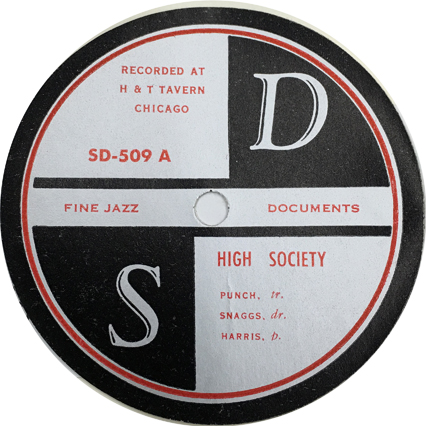
On January 28, 1941, Steiner and Davis had shlepped their equipment to the H & T Tavern to record New Orleans trumpeter Punch Miller. They got six usable sides out of their efforts. Steiner planned to put Punch Miller tracks out on S D, or so it was announced in July 1945, in George Hoefer’s Down Beat column. But the releases were much delayed; for the longest time we thought they had been canceled. However, the John Steiner Collection at the University of Chicago Library includes loose labels to nearly everything that Steiner released, on S D, Paramount, and the other imprints he was associated with. In later years, Steiner would often include a label or two in his return correspondence with historians and jazz collectors. The Steiner Collection includes printed labels to both sides of S D 509 and 510, with a layout seemingly modeled after the labels to S D 507.
The actual release on 509 and 510 could have been delayed as far as 1950. And there's no assurance that even then either side was pressed beyond what Steiner called "experimental lots." S D 509 and 510 were not included in Steiner's 1950 catalogue, in the two booklets that were included with some of the early Paramount LPs in 1952 and 1953, or in the lists on the backs of various of those LPs. We won't know the matrix numbers and we won't know who pressed the records until we see an actual copy.
Nearly everyone knows this session from the four tracks from the 1952 LP release on Paramount CJS102— which, it turns out, are not the same four that were originally released.
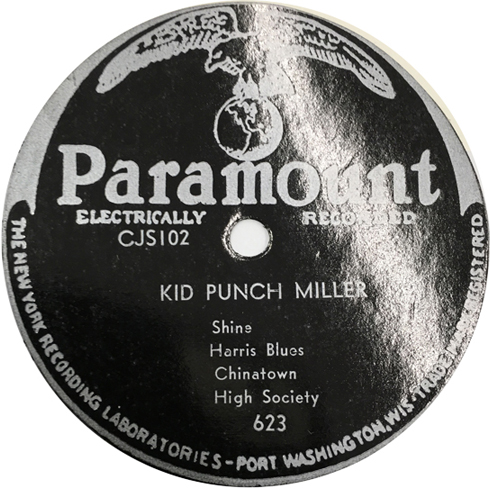
Ernest "Punch" Miller was born in Raceland, Lousiana (on June 10, 1894 or December 24, 1897, depending on which source you believe). He worked with legendary New Orleans bandleader Jack Carey ("Tiger Rag" was once known as "Play Jack Carey"), and in army bands during his service in World War I. In 1926, he moved to Chicago, where he worked but did not record with Freddie Keppard and Jelly Roll Morton, and did both with Al Wynn. As a member of Tiny Parham's big band, Miller appeared on three of Parham's Victor recording sessions. Victor wanted a cut-down ensemble and Parham alternated Miller on a platoon system with Roy Hobson, who was not nearly so good a jazz player. Miller's sessions with Parham took place in 1928 and 1929. Before the Depression killed off jazz recording in Chicago, he did a session in 1930 with Frankie Franko's Louisianians. Up through the mid-1940s he often led his own bands in Chicago.

Ernest "Punch" Miller (tp, voc on %); Ace Harris (p, voc on #); Clifford "Snags" Jones (d).
H & T Tavern, Chicago, January 28, 1941
| High Society | S D 509 A, Paramount CJS102 | ||
| Bugle Call [Bugle Call Rag^] | S D 509 B, American Music AMCD-40^ | ||
| Panama | S D-510 A | ||
| Harris' Blues | S D-510B, Paramount CJS102, American Music AMCD-40 | ||
| Shine | Paramount CJS102, American Music AMCD-40 | ||
| Chinatown [Chinatown, My Chinatown^] | Paramount CJS102, American Music AMCD-40^ |
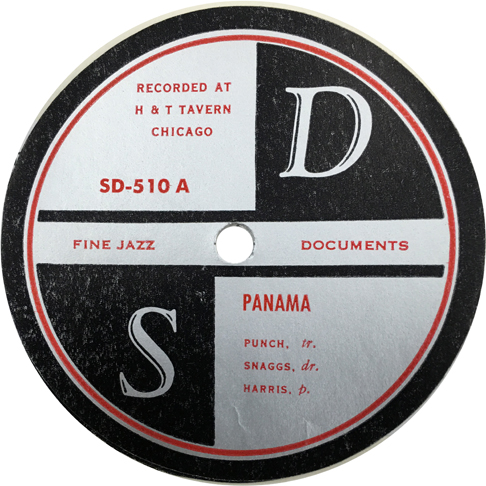
After Steiner and Davis recorded him, Miller wandered around the country for a while. He resurfaced in Chicago in 1944, where the rival Session operation recorded him in the studio on June 12. In 1947, he moved his base of operations to New York City, where he would next record for Savoy (two sessions that year). For roughly the next decade he toured in circus bands and R&B combos. After returning to New Orleans in 1956 to participate in the traditional jazz scene there, he recorded fairly often up through 1969, becoming a regular at Preservation Hall, and was featured in a documentary film in 1971. Punch Miller died in New Orleans on December 2, 1971.
Born at 2310 2nd Street, New Orleans, in 1900, Clifford Jones began playing the drums while in elementary school. (His nickname, "Snags," was a slightly more decorous version of "Snaggletooth.") His first professional job with was with the legendary (and completely unrecorded) cornetist Buddy Petit. Subsequently Snags worked for several years in Jack Carey's band and also gigged with Papa Celestin and A. J. Piron. In 1922 he joined the migration to Chicago, where he initially worked under another New Orleans expatriate named Tig Chambers. In 1924 he was a member of King Oliver's Creole Jazz Band while it still included Louis Armstrong. He made his first records in 1926, providing accompaniment for blues singers with Richard M. Jones at the piano. In 1928, he recorded with Junie C. Cobb, Jimmy Wade, the Dixie Four, and the State Street Ramblers. After a sojourn in Milwaukee, he labored in relative obscurity in Chicago for most of the 1930s.
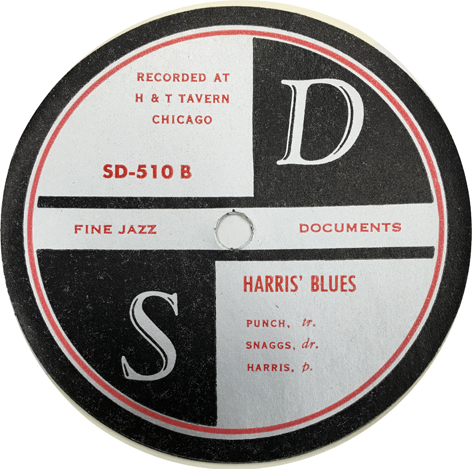
After appearing with Punch Miller on Session, Snags recorded with Preston Jackson for Victor (October 31, 1946; two of these sides featured him as a blues singer); during that same year he worked with Darnell Howard and Bunk Johnson. He died in Chicago on January 31, 1947.
In their recordings of live sessions, Steiner and Davis were partial to piano players. This was partly out of personal interest—Steiner was a proficient amateur pianist whose jazz styling revealed a heavy Earl Hines influence. There was also the financial angle—a solo piano player was more economical than a combo. Consequently, there were recordings by Cow Cow Davenport, Jack Gardner, Tut Soper, Cassino Simpson, Mel Henke, Chet Roble, and Frank Melrose. Still, most of these sessions did not end up on S D. One reason is that many of the live concerts Steiner and Davis recorded in the 1940s were done on 16-inch discs, often yielding tracks that were too long for release on 10-inch S D 78s. (Unlike Session, S D did not experiment with the 12-inch format.) The Cassino Simpson session, from 1942, is the second live session to see release on a S D 78 (and then just one side was used, which was held for release until the end of 1947).
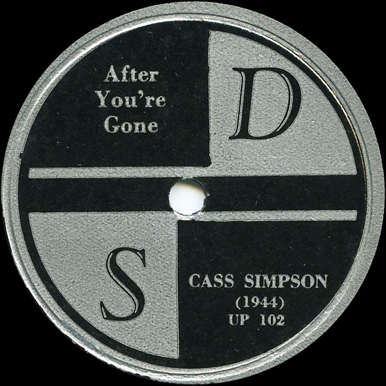
Cassino Simpson (p).
Elgin Mental Hospital, Elgin, Illinois, May 17, 1942
| Tea for Two | Paramount CJS109, Chicago Piano 12-001 | ||
| It Don't Mean a Thing | Paramount CJS109, Chicago Piano 12-001 | ||
| Blues Variations | Paramount CJS109, Chicago Piano 12-001 | ||
| Moonglow | Paramount CJS109, Chicago Piano 12-001 | ||
| Song of the Wanderer | Paramount CJS109, Chicago Piano 12-001 | ||
| Little Joe | Paramount CJS109, Chicago Piano 12-001 | ||
| Lost in a Fog | Paramount CJS109, Chicago Piano 12-001 | ||
| Variations on Variations [Variations^] | Paramount CJS109, Chicago Piano 12-001^ | ||
| UP 102 DP | After You're Gone [sic] | S D Merry Christmas 1947* |
The Cassino Simpson outing was more of Steiner and Davis's more daring endeavors. They recorded Simpson while visiting him at the Elgin Mental Hospital, where the famed pianist was a patient. They'd became aware of his presence there in 1940, but were not able to record him then, and might very well not have been able to record him at all. In a reminiscence about his location recording trips with Hugh Davis, before World War II rationing set in, Steiner said:
In the old days — about the fall of '40, anyway we had gas, Davis and I with an evening for idle pleasure, low on dough, and by chance carrying our several hundred pounds of recording junk in the back, set out to locate TALENT. It seems we were at the moment definitely hyped by having 'discovered', at least for ourselves, within the preceding month or two Cass Simpson in Elgin, the Bert Bailey Six in Milwaukee and the unbelievably magnificent (in the Panassie idiom) Kenneth Morris, director of music at the colored First Church of Ascension. (The Jazz Session, No. 5, January-February 1945, p. 3)
(There is evidence from the Steiner Collection that they made location recordings at the church, though not for release on S D. We don't know what happened with the Bert Bailey Six.)
Swiss jazz researcher Johnny Simmen ("Cassino Simpson," Storyville no. 28, April-May 1970, pp. 123-127) noted that Steiner wrote him in 1940 about discovering Simpson at the mental hospital, remarking, however, that there was "no hope of getting him to record." Obviously somebody had talked to someone and something had changed by 1942. However, Simmen, like J. R. Simpson in his 1955 Jazz Journal article on Cassino Simpson, dated the recordings to 1944 and 1945.
The only track to be released on a 78 appeared on S D Merry Christmas 1947, a special gift record issued in a limited edition. The Merry Christmas 78 looks hastily put together, as "After You've Gone" is misrendered, and the recording date is given as 1944 (though that might have been a strategic decision, safely postdating S D's deal with the Union). In the trail-off shellac what we've written as DP is a monogram of a D with a P stuck in it; it stood for Dike-Polzin, a company in Pasadena, California that made masters and mothers for pressing companies like Bishop. On the flip side was a Red Nichols side of a radio broadcast transcription that Steiner picked up in Los Angeles (see session SD16 below). For a discography (by John Steiner himself) of the Merry Christmas releases, see the Matrix 21 (January 1959), p. 21, where gave the date for the Simpson side as May 17, 1942.
Steiner may have originally intended a different discmate for "After You've Gone." The January 1954 issue of the Record Changer (p. 24) offered at auction an unnumbered S D coupling of the Mel Henke Trio playing "Hindustan" and Cassino Simpson playing what was described as "After U Gone." We know of no actual S D releases by Mel Henke, a pianist then active in Chicago and Milwaukee who operated his own label for a brief period. In 1946 and 1947, Henke was signed to other companies—notably Vitacoustic, to which he was under contract in December 1947
The remaining sides would lie on the shelf until Steiner revived the Paramount label in 1949 and began issuing Paramount LPs in 1952. In fact, Paramount CJS 109 didn't appear till 1954. Chicago Piano 12-001 was released in the 1970s; Cassino Simpson was given the B side while the A side was taken up with 4 recordings of Kansas City Frank Melrose that Steiner got from the American Record Company and 2 from Paramount (well, sort of, where the Paramounts were concerned) and initially released in 1952 on Paramount CJS 103, a complicated entity to be described later on.
Steiner and Davis had developed an appreciation for Simpson from his work on several Paramount sides, notably the ones he made with singer/pianist Laura Rucker, who turned over the keyboard duties for the 1931 session (two of these sides were selected for reissue in the S D 100 series; see SDR3 and SDR4 below).
Pianist Cassino Wendell Simpson was born in either Chicago or Venice, Italy, on July 22, 1909. He recorded as early as 1923 with trumpeter Bernie Young and then worked with Arthur Simm's orchestra, which was subsequently led by Young. Simpson left the Young orchestra in 1930. For a time he worked with Erskine Tate. In 1929, Simpson made some valuable jazz recordings with Jabbo Smith and Ikey Robinson. During 1931-33, Simpson led his own bands in Chicago, followed by a stint accompanying Frankie "Half Pint" Jaxon.
In 1932 or thereabouts, Milt Hinton played in a band with Simpson at the Showboat. The front man was trumpeter Jabbo Smith; John Thomas was the trombonist; Scoops Carry, Jerome "Don" Pasquall, and Scoville Brown made up the reed section; Ted Tinsley was the rhythm guitarist; and Floyd Campbell (later replaced by Richard Barnet) was in the drum chair.
In his memoirs, Hinton recalled Simpson this way:
In addition to playing the piano, Cass Simpson wrote most of the arrangements. He was a brilliant musician—one of the guys from that era that I'll never forget. He was light complected and his face was scarred from small pox. He always smoked a cigar when he played and he'd let the ashes fall all around him. After he'd smoked it down to a little stub he'd put the whole thing in his mouth, chew on it for fifteen or twenty minutes, then spit out whatever was left. By the end of the night the bandstand was filthy and also smelled pretty foul.
We played what would probably be called New Orleans-style. Cass actually wrote out the parts so the reeds and brass could harmonize during the solos. He also composed new tunes, and for some reason always named them after soul food like neckbones and rice, mustard greens and pig tails, cabbage and black eyes.
Cass was also an unbelievable piano player. He had Art Tatum's depth and Oscar Peteron's fire. I've never really heard anybody else play that way. But like a lot of geniuses he had some serious mental problems and I think all of us knew it, even back then. (The Bass Line, p. 50)
After the club owners fired Jabbo Smith, who often missed the entire first set, and sometimes skipped out before the night's work was over, Simpson took over as leader. The band continued for a little while, doing freelance jobs and working a couple of nights per week at the Regal Theater.
In 1935, the mental problems came to the fore when Simpson tried to kill "Half-Pint" Jaxon. Cassino Simpson was admitted to the Elgin Mental Hospital. In the hospital he played drum in the marching band and piano and vibes in the dance band. As might be expected, the S D recordings were the only ones he made in the asylum. He died there on March 27, 1952.
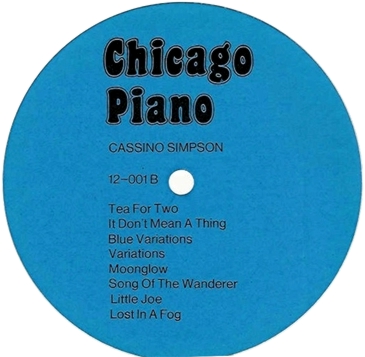
Simpson sources: John Chilton, Who’s Who of Jazz: Storyville to Swing Street (Philadelphia: Chilton Book Company, 1972): 338; Milt Hinton, The Bass Line: 50; Tom Lord, The Jazz Discography, Volume 20 (West Vancouver, B.C.: Lord’s Music, 1998): S729.
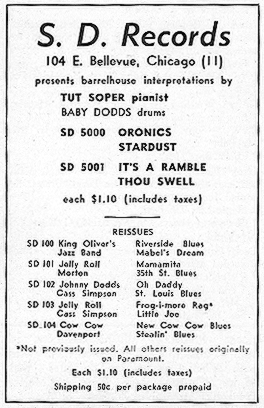
Newly recorded material on S D began to appear on a 5000 series, on which Steiner put out releases by pianist Tut Soper and vibist Red Norvo with the Stuff Smith Quartets. S D 5000 and 5001, both by Tut Soper, were on sale by mid-May 1944. An advertisement for S D Records in Down Beat (May 15, 1944) lists 5000 and 5001 along with 100 through 104 (see below for the 100 reissue series).
The August 15, 1944 issue of Down Beat announced that 5000 and 5001 could also be purchased on wire, at a time when this predecessor to tape recording was not yet seen as a retail medium. S D was a true innovator in this realm. According to Bjöaut;rn Englund in his article "Early Pre-Recorded Tapes (1955-1957), "In the 1940s the Webcor wire-recorder achieved some popularity and John Steiner in Chicago issued a few titles from his Steiner-Davis label as prerecorded wires. This is the only label known to have done so" (Names & Numbers 36, January 2006, p. 38). Aristocrat briefly showed an interest in wire recording, though not for release. Other record companies didn't get into the action until 1950 or later, when some began offering prerecorded tapes.
5000 and 5001 were listed again in S D's advertisement in The Jazz Record for November 1944.
S D 5002 and 5003 were also planned in 1944. But so far as we can determine, they didn't make it into circulation before the fall of that year, when Steiner quit trying to press S D records. After which, they spent an amazingly long time in limbo... we have no evidence that they were released before 1949. But more about all of that below.
The labels on 5000 and 5001 listed the company’s address, but misspelled Bellevue as "Bellvue." As he would do on all subsequent sessions, Steiner assigned master numbers according to the date of the recording and the take.
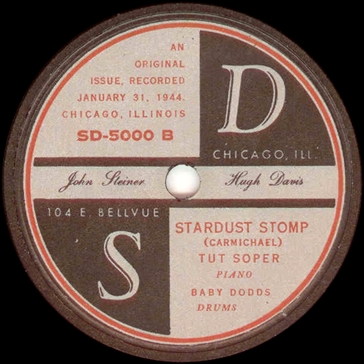
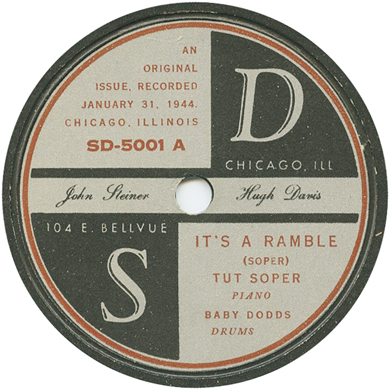
Oro "Tut" Soper (p, vcl -1); Warren "Baby" Dodds (d, vcl -2).
Jack Gardner's apartment, Chicago, January 31, 1944
| 13144-1; CRC 9132A 13144-1 |
Oronics [No. 1] (Soper) | S D 5000 A | |
| 13144-2 | Butter & Egg Man (#1) -1, 2 | unissued | |
| 13144-3 | Butter & Egg Man (#2) -1, 2 | — | |
| 13144-4 | That's a Plenty | Baby Dodds 2 | |
| 13144-5 | Oronics No. 2 (Soper) | unissued | |
| SD 13144-6A ; CRC 9135 A 13144-6 A |
It's a Ramble (Soper) | S D 5001 A | |
| 13144-7 | Right Kind of Love -1 | unissued | |
| 13144-8;
CRC 9133 A
13144-8; DP 7 |
Thou Swell (Rodgers-Hart) | S D 5001 B | |
| 13144-9 | Keeping Myself for You | unissued | |
| 13144-10 ; CRC 9134 A13144-10 DP 7 | Stardust Stomp (Carmichael) | S D 5000 B | |
| 13144-11 | Oronics No. 3 (Soper) | unissued | |
| 13144-12 | Tea For Two (drum novelty) | Baby Dodds 2, Dan [Jap] VC-4013, VC-7015 |
Tom Lord in a note below his listing said that there may have been a release on a 16-inch disk that contains this entire session. (Most likely, he is just referring to the session master; 16-inch acetates and transcription disks were common at this time.) Lord, like some other discographers, refers to all S D releases as "Steiner-Davis." But none of the labels actually read "Steiner-Davis." In articles about his company and in advertisements, John Steiner followed the punctuation practices of his day and wrote "S. D.," but there are no periods on the labels. Nor was there ever a hyphen between the S and the D.
S D 5000 and 5001 were apparently pressed in two distinct runs. Some copies (including S D 5000 and 5001 in Konrad Nowakowski's collection) show the matrix numbers shown at the top, with CRC 9100 series numbers in the trailoff area. CRC was Chicago Recording Company, and by implication the pressings were done at a plant in the Chicago area.
Other copies (such as those in Tom Kelly's collection) leave off the CRC numbers and show a monogram (a D with a P stuck in it) and a number 7 in the runoff on one side. The same DP monogram can be seen on some Session releases from this period. The Bishop pressings date from 1947 (S D 5000 and 5001 were not in Steiner's initial order) through 1950 (Steiner got his masters back from Bishop in September of that year). During that period, Steiner often ordered pressings of multiple records in very small quantities each.
We now know, from the correspondence with The Bishop Presses that John Steiner largely preserved (now in Box 26 Folder 22 in the John Steiner collection af the University of Chicago), that DP stood for Dike-Polzin Co., Record Processing, which was located at 221 South Arroyo Parkway in Pasadena, California. Dike-Polzin, which later changed its name to Deeco, did masters and mothers for many of the records that Bishop pressed in South Pasadena.
S D 5000 and 5001 remained in Steiner's catalog until at least 1952, as they are advertised in a booklet that was included with his first Paramount10-inch LP release, Paramount CJS101.
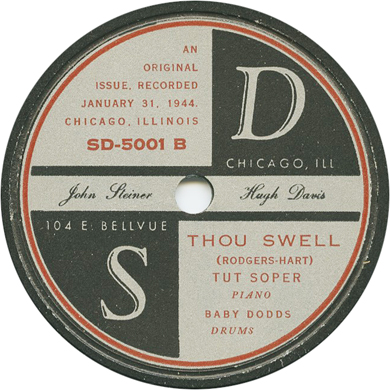
Pianist Tut Soper was born Oro M. Soper on April 9, 1910. In the early 1920s, Soper made a record on OKeh with a group of kids, all 13 and under, called The Five Baby Shieks. Besides Soper on piano, they included Art Elefson on drums, Howard Snyder on sax, and Elmer Fearn on violin. By the late 1920s he was a regular in Chicago clubs, despite being underaged, and performing with Bunny Berrigan, Wingy Mannone, Boyd Brown, and Floyd Town. After years of playing in bands, in the late 1930s Soper went solo, introduced vocals to his repertoire, and played in such clubs as the legendary Three Deuces (222 North State).
By the war years, Soper could be found in the Randolph Street nightclub district. He was playing around the corner from Randolph Street at the Capitol Lounge on State when his S D recordings were made. Steiner and Davis teamed Soper up with Dodds in pianist Jack Gardner’s apartment for the session. Gardner owned a particularly fine piano, which is why the session was held in his place, at 102 East Bellevue, a basement apartment located in the same complex as John Steiner's. Jazz fans tend to revel in improvisation, and Down Beat columnist George Hoefer loved the idea at how "impromptu" the recording was, as Soper and Dodds had never met before, and had to feel each other out in the recording process.
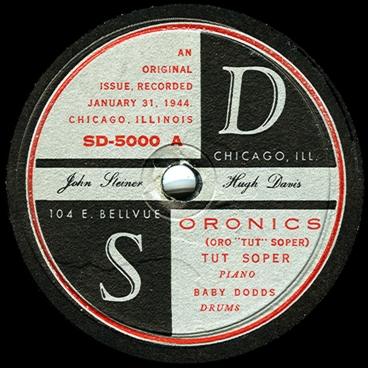
Lord lists "Oronics No. 3" as being released on S D 5000, but Hoefer in his "Hot Box" column of 15 June 1944 lists the title as simply "Oronics," and gives the master number as 13144-1. He goes into detail how the "first test" of the number turned out to be the best, and ended up being used for release. We'll go with Hoefer on this; besides, the matrix numbers on S D 5000 back him up.
Down Beat reviewer John Lucas—who tended to give favorable reviews to his collector colleagues’ product—cited these releases as "some of the finest jazz piano waxed in many years." He raved about each one of the songs, and concluded, "The rip-rattling drum accompaniment provided by the one and only Baby Dodds simply could not be touched by anyone else. If Soper is super, Dodds is at once devastating, dynamic, and droll!"
In a lengthy review published in the October 1944 issue of The Jazz Record, George Avakian gave effusive praise to S D 5000 and 5001. "Picture Earl Hines in the full flower of his wildest period, playing as though it were his last chance to explode through with vital ideas of earth-shaking consequence. This is Tut Soper; an exciting, intensely live pianist whose work doesn't merely "send" you the way many agitated instrumentalists can—it reaches out, grabs you by the throat, and shakes and chokes hell out of you" (p. 3). Avakian contrasted Soper's genuineness and avoidance of clichés with the mannerisms of "the present-day frantic clique," into which he went so far as to lump "such hopeless musicians as Lionel Hampton, Art Tatum, Roy Eldridge, Dizzy Gillespie, and a whole string of trumpet players, electric guitar virtuosos, and Hazel Scotts" (p. 3). Out of the four, Avakian declared that "[t]he originals—Oronics and It's a Ramble—are my pet sides, displaying Tut's talents in two tempos and two moods, both nonetheless full of his overall excitement. The first is sheer panic, but good; the Ramble is reflective and rather interestingly developed from the melodic view. The others are Soper franticizations of Thou Swell and Star Dust, and the tunes improve under his manhandling." (p. 3.) Of Dodds' contributions, Avakian complained (p. 11) that the drummer "loses much of his subtlety" on Oronics, but praised him for his rapport with Soper elswhere on the session.
John Chilton described Soper as one of the leading pianists in Chicago, and credited him with working with Bud Freeman, Wild Bill Davison, Boyce Brown, Bud Jacobson, and Eddie Wiggins, among others. In the early 1950s, Soper worked in California with Muggsy Spanier and Marty Marsala. He toured with Eddie Condon in 1960.
Soper in his later years worked mostly as an insurance salesman for the Chicago Motor Club. He died in March 1987. His obit described him as a former jazz pianist, who had played for 50 years in "some of Chicago’s most famous jazz clubs and with the bands of Gene Krupa and Bud Freeman."
Soper sources: M/Sgt. George Avakian, "Records—Old and New," The Jazz Record, October 1944, pp. 3, 11; George Hoefer Jr., "The Hot Box," Down Beat, 15 June 1944; [John Lucas] "Diggin’ The Discs," Down Beat, 15 July 1944, p. 8; Catherine Jacobson, "Oro ‘Tut’ Soper," Jazz Vol. 1, No. 10 (December 1943): 8-9; "Oro Soper" [Obit], Chicago Tribune, March 24, 1987; Tom Lord, The Jazz Discography, Volume 21 (West Vancouver, B.C.: Lord’s Music, 1999): S1057.
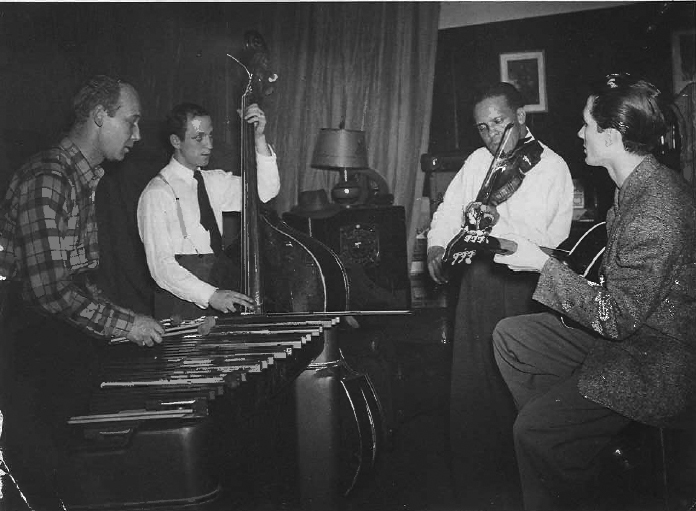

John Steiner’s North side apartment at 104 East Bellevue was the location for the next S D session, which teamed up two legends of jazz—vibist Red Norvo and violinist Stuff Smith—accompanied by Remo Palmieri on guitar and Clyde Lombardi on bass.
Anthony Barnett has recently revised his discographical listing for this session, and we are following him here.
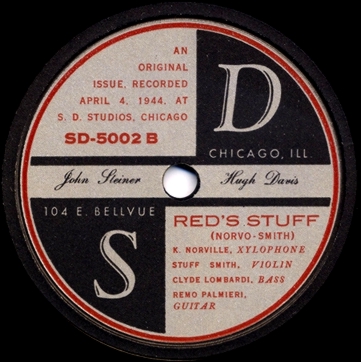
Stuff Smith (vln); Kenneth Norville [Red Norvo] (xyl); Remo Palmieri (eg); Clyde Lombardi (b).
John Steiner's home, Chicago, April 5, 1944
| unknown master number 4544-0B as released |
Rehearsal [Red’s Stuff (Norvo-Smith)] | S D 5002 A (part) | |
| 4544-00 4544-0B as released |
Rehearsal [Red’s Stuff (Norvo-Smith)] | S D 5002 A (part) | |
| 4544-1 | Red’s Stuff (Norvo-Smith) | unissued | |
| 4544-2 | Red’s Stuff (Norvo-Smith) | unissued | |
| 4544-3 | Red’s Stuff (Norvo-Smith) | unissued | |
| 4544-4a | Red’s Stuff (Norvo-Smith) [false start] | unissued | |
| 4544-4b | Red’s Stuff (Norvo-Smith) | unissued | |
| 4544-5B | Red’s Stuff (Norvo-Smith) | S D 5002 B | |
| 4544-6 | Confessin’ (Neiburg-Dougherty-Reynolds) | unissued | |
| 4544-7B | Confessin’ (Neiburg-Dougherty-Reynolds) | S D 5003 A | |
| 4544-8 | Confessin’ (Neiburg-Dougherty-Reynolds) | unissued | |
| 4544-9 | Confessin’ (Neiburg-Dougherty-Reynolds) | unissued | |
| 4544-10 | A Fawn Jumped at Dawn (Palmieri) | unissued | |
| 4544-11B | A Fawn (Palmieri) | S D 5003 B | |
| 4544-12 | Blue Hugh’s Hue | unissued |
We drew our information on the session from Anthony Barnett's book Desert Sands, the definitive bio-discography of Stuff Smith. (See p. 111 for the discographical entry.) Although Tom Lord used Barnett as a source, several errors crept into the listing for this session in Lord's Jazz Discography. Recently, Anthony Barnett discovered that the Rehearsal, as released on S D 5002 A, is actually an edited composite of 4544-00 and another lacquer that apparently has been lost. Meanwhile, 4544-4b was not used for the released "Rehearsal," as previously thought; it is still unissued. Courtesy of Anthony Barnett, we have updated this session listing with the latest information available.
As released on S D 5002 A, the "Rehearsal" (of "Red's Stuff") consists of edited material from two masters. The first half of the released side is the extant master 4544-00, with a minute or so of talk and fragmented passages edited out. The second half of the released side (music, no talk) is from a master apparently now lost (maybe it was 4544-0); we of course don't know whether all of the lost master was used or not.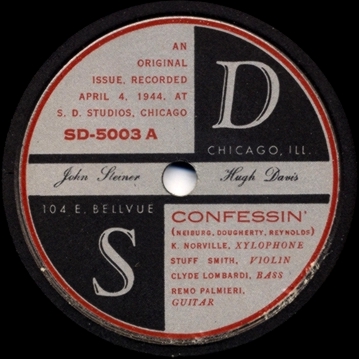
On the labels to S D 5002 and 5003, all four musicians are listed, but Red Norvo appears under his real name, as "K. Norville." The date is given on the label as April 4, 1944, but the matrix numbers indicate April 5, which is confirmed by the session sheet.
The 78 lists "Red’s Stuff" on the label while the recording sheet says "Red Stuff." On Side A of S D 5002, Anthony Barnett indicates that track 4544-00 (possibly edited) is followed by material from a lacquer that may be lost. A cassette copy of the session made by John Steiner gave the last track the title "Blue Hugh's Hue"; on the session sheet, the piece was untitled.
A copy of S D 5002 in the collection of Konrad Nowakowski shows SD 4544-0B on the A side, and carries the Dike-Polzin monograph in the runoff area. Copies with the DP were pressed by Bishop in South Pasadena, California. The B side of Nowakowki's copy shows DP and B9 in the trailoff area. A close inspection of S D 5003 is also warranted.
As noted by Barnett, "Red’s Stuff" would be recorded for Keynote in July 1944 (on a session that included Teddy Wilson and Slam Stewart) as "Blues à la Red." Norvo subsequently recorded "Blue Hugh's Hue" for World Transcriptions (in May or June 1944) and for V Disc (in May). Both of these later recordings used the title "Red Dust" (credited to Fletcher Henderson).
For another photo taken at the session, showing the musicians listening to a playback, see the AB Fable Archives site.
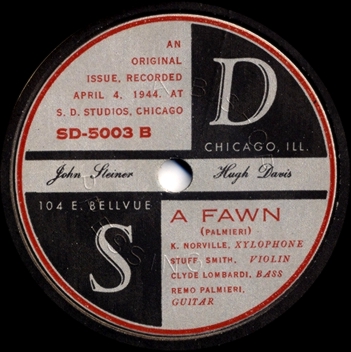
The release dates for S D 5002 and 5003 continue to puzzle us. The release numbers and the appearance of the labels indicate a planned release in 1944. S D 5002 and 5003 were announced by Leonard Feather in the 1945 Esquire Jazz Guide (p. 123, in a volume that was actually published in December 1944).
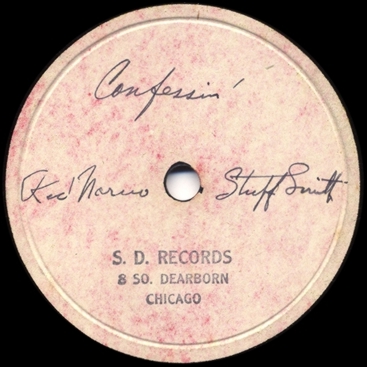
However, a test pressing of S D 5003 shows the 8 South Dearborn address, which is from 1947 or 1948. And Charles Delaunay's Hot Discography from 1948 lists S D 5000 and 5001—but not 5002 and 5003. In the Steiner-Bishop correspondence, the first request for pressings of 5002 and 5003 was sent on March 4, 1949. Steiner was billed on March 31, 1949 for 227 copies of S D 5002, probably (the invoice repeats 5003 for two different records), and 229 copies of S D 5003. These were good-sized orders for Steiner, though not necessarily the biggest he would make for these two 78s. The first known advertisement for 5002 and 5003 appeared in the Record Changer for July/August 1950. (And a list of titles for sale included in a booklet with Paramount LP CJS101, which was released in 1952, mentions "Red Norvo and Stuff Smith Quartet" but mislists the items as S D 5000 and 5001...) Since we haven't found an earlier review or ad for these 78s, we have to go with April 1949 as the release date, but we find the length of the delay intensely puzzling. Were a few demo copies circulated in 1944, followed by a commercially serious pressing run in 1949? Could there have been some legal tie-up?
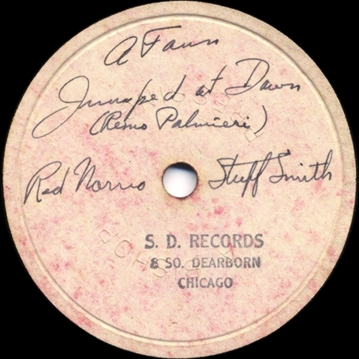
Red Norvo was born Kenneth Norville on March 31, 1908, in Beardstown, Illinois. He built his reputation playing the xylophone and marimba, but also played piano. He began his career touring with a marimba band, the Collegians, in 1925. His first session under his own name was in 1929 for Brunswick Records, but it went unreleased. His next recording opportunity came in 1933. Meanwhile, he had been working with the Paul Whiteman Orchestra in 1931, and there met Mildred Bailey, to whom he would be married for 12 years.
In 1933 Norvo got a band together, Red Norvo and His Swing Septet, and began recording for Columbia. Thereafter he was rarely out of the recording booth. His last Columbia recording was done in 1942. From 1935 to 1944 Norvo led bands from small combos to large orchestras. In October 1943 he recorded V-Discs for broadcast to the armed services. By this time he had switched from xylophone to vibraphone.
The April 1944 S D session was something of a coup for Steiner and Davis. They were of course recording him for what he represented in the past. Although Steiner would eventually issue a live broadcast featuring Charlie Parker and Dizzy Gillespie, it is most unlikely that he and Hugh Davis were anticipating anything like Red's famous 1945 session for Comet that included Bird and Diz.
In 1944, Norvo disbanded his sextet and joined the Benny Goodman band, and the following year saw him in Woody Herman’s band. In 1947, moved to Santa Monica, California and returned to leading his own combo. His 1950-1951 trio with Tal Farlow on electric guitar and Charles Mingus on bass was one of the leading "cool jazz" ensembles. During the 1960s, he had a long residency at the Sands Hotel in Las Vegas. Norvo had to retire from playing after suffering a stroke in 1986; he died in Santa Monica, California, on April 6, 1999.
Norvo sources: John Chilton, Who’s Who of Jazz: Storyville to Swing Street (Philadelphia: Chilton Book Company, 1972): 277-78; Barry Kernfeld, "Red Norvo," The New Grove Dictionary of Jazz (London: Macmillan, 2002, 2nd edition, Vol. 3, pp. 165-167); "Red Norvo, 91, Who Introduced Xylophone to Jazz," Chicago Tribune, 8 April 1999; Tom Lord, The Jazz Discography, Volume 16 (West Vancouver, B.C.: Lord’s Music, 1997): N350.
We will be adding a capsule biography of Stuff Smith one of these days.
Smith sources: Anthony Barnett, Desert Sands: The Recordings and Performances of Stuff Smith. (Lewes, East Sussex: Allardyce, Barnett, 1995).
Probably intended at one time for release in the 5000 series was a session by pianist Chet Roble and his group. All we know about this one is that Steiner cut it in the summer of 1944; an item in the August 15 issue of Down Beat signaled that the group had been recorded "for S D." But no releases ever emerged (even years later, when Steiner was putting out LPs on Paramount) and it is doubtful whether any tracks are still extant. Roble also recorded, with his trio of Boyce Brown on alto sax and Sammy Aron on bass, in July 1946 for Morton Sultan's Detroit-based label. But the sides were never released. In the 1950s, Roble made a single for Topper (1952) and an LP for Argo (1958), more pop-oriented efforts from a period in which he was working piano bars.
For releases planned after he stopped trying to press S D's in the fall of 1944, Steinter dropped a zero out of the 5000 series numbers and hopped from 5003 to 504. Of course, the earliest session listed here (Punch Miller, 1941) ended up as the last in the series, on 509 and 510.
While the 500 series releases got going in January 1947 (Steiner made his first pressing order from Bishop on December 16, 1956, taking delivery early the next month), the sessions they were drawn from took place in 1941, 1944, and 1946. In January 1944, Steiner and Davis waxed their friend, pianist Jack Gardner, accompanied by Baby Dodds on drums. Their Gardner 78 paired one number from the January session and another from a session in June 1944. We should note that both the 5000 and the 500 series featured a label design in which the S was in the lower left quadrant and the D in the upper right, not connected by any hyphen. This is why refer to the label as S D, not S-D.
We know of releases on 504, 505, 506, 507, 508, 509 and 510.
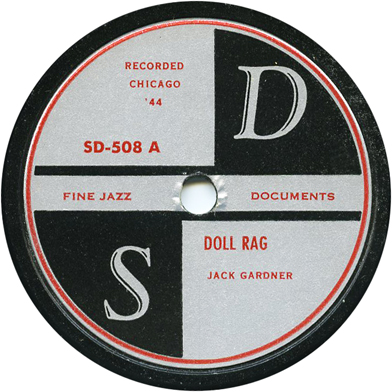
Jack Gardner (p); Warren "Baby" Dodds (d).
503 West Aldine, Chicago, January 31, 1944
| SD1314461B DP | Doll Rag | S D 508 A |
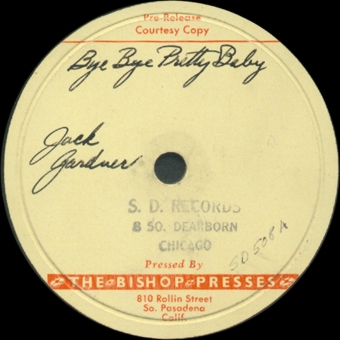
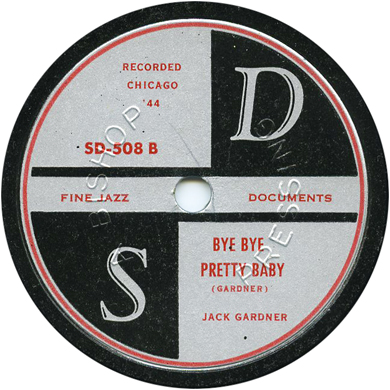
Jack Gardner (p).
503 West Aldine, Chicago, June 30, 1944
| SD63044-9B DP | Bye Bye Pretty Baby (Gardner) | S D 508 B | |
| Rolling around in Roses | unissued |
The copy of S D 508 in Tom Kelly's collection is stamped "A Bishop Pressing" on the B side, under the label, in a fashion that is familiar from Bishop's 1946 and 1947 pressings of Session 78s. A copy in Konrad Nowakowski's collection shows 61B in the runoff area (we'd previously construed this as GIB); both sides carry the Dike-Polzin monograph in the runoff area. A test pressing of 508, in Volker Dorendorf's collection, was also done at Bishop, a pressing plant located in South Pasadena, California, where it began operations in April 1946. The test pressing gives "Paper Doll" as the title of "Doll Rag."
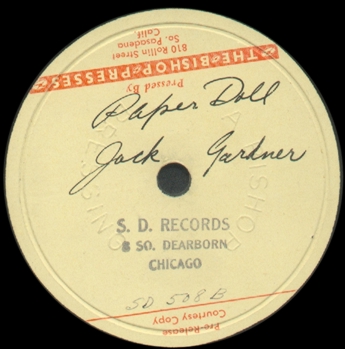
S D 507 and 508 were delayed for more than a year past 504 through 506. 504 through 506 were ready for release in January 1947. 507 and 508 were released in May 1948. On May 4, The Bishop Presses billed Steiner for 116 copies of S D 507 and 198 of S D 508, 20 cents a pressing. Both were advertised in the Record Changer for June 1948—but not mentioned in the company's ads in the same magazine that appeared in the July, August, and December 1947 issues.
Jack Gardner was born Francis Henry Gardner, August 14, 1903, in Joliet, Illinois. At the age of eight he began playing piano, after his family had moved to Denver. He moved to Chicago 1923 to play in Spike Hamilton’s Band. Jack Gardner first recorded in 1924 for OKeh, leading his own group. He did another session for the label the following year, and led his own touring band in the late 1920s. He also recorded with Wingy Manone (1928) and Jimmy McPartland (1936). In 1937 Gardner moved to New York. During 1939-1940 Gardner served as pianist for the Harry James Orchestra. Returning to Chicago, he led a trio at the Silver Palm (1117 West Wilson) for a while, and developed a friendship with John Steiner, out of which the S D session arose. Gardner subsequently moved to Texas. He died in Dallas on November 26, 1957.
Gardner sources: John Chilton, Who’s Who of Jazz: Storyville to Swing Street (Philadelphia: Chilton Book Company, 1972): 129; Tom Lord, The Jazz Discography, Volume 7 (West Vancouver, B.C.: Lord’s Music, 1993): G47-48.
The session of June 30, 1944, also included 3 titles laid down by an unusual trio that consisted of Gardner at the piano, Red Nichols on cornet, and Vic Engle in the drum chair. The story of the June 30th outing—a truly impromptu affair—was told in an article on Red Nichols in Record Research (combined issue 96-97, p. 10). Not long after he and his wife bought a house in Los Angeles, Nichols was en route to his new home when he passed through Chicago. "Red was staying at the Sherman Hotel and met Vic Engle at the Croydon Hotel by chance. They phoned John Steiner to ask 'what's happening?' On a quick impulse they set up a recording date. They used Jack Gardner because they could get his piano and room for the job—it took place at 503 W. Aldine St. on June 30. It was a tentative deal, but John liked the results immediately and paid off. That trio never worked before or after the two hours before Red's plane left for the coast."

Red Nichols (cnt); Jack Gardner (p); Victor Engle (d).
503 West Aldine, Chicago, June 30, 1944
| 63044-1 | Cheerful Little Earful | test pressing | |
| 63044-1B | Cheerful Little Earfull [sic] | test pressing | |
| 63044-3B | Cheerful Little Earful | S D 507 A | |
| 63044-4B | I’ve Got a Woman [She’s Funny That Way] | S D 507 B, VJC VJC1009 (CD) | |
| 63044-5B | Smoke Gets in Your Eyes | test pressing |
The copy of S D 507 in Tom Kelly's collection was pressed by Bishop, an outfit in South Pasadena, California whose major customers were Jump, Session, and some other small indies with a jazz orientation. S D 507 dates from May 1948; on May 4, Steiner was billed for 116 copies of S D 507. A test pressing from this session—we are not sure about the coupling—was mentioned in a December 1947 article.
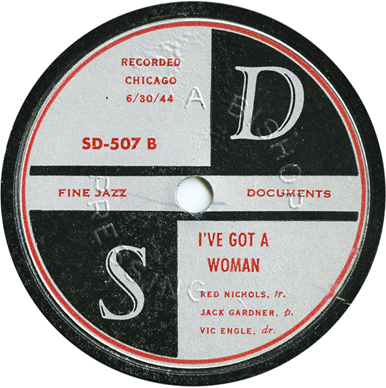
Lord claims that in all only 300 copies of S D 507 were pressed—this is according to information he had received from collector Jack Hester. We don't have documentation for later pressing runs on 507, but from the first run, the total seems about right. The VJC CD was titled Trumpet Royalty; the remainder of its cuts were by other artists.
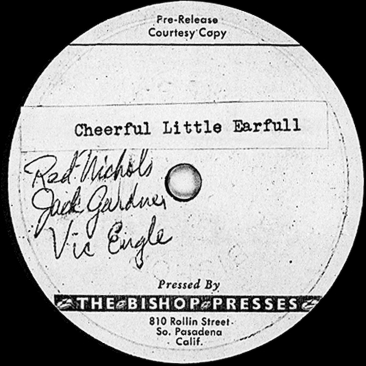
One 78-rpm test pressing, made by Bishop, of 63044-1B backed by 63044-5B is now in the collection of Warren Hicks. At least one other test pressing is known to be extant; it has 63044-1 on one side.
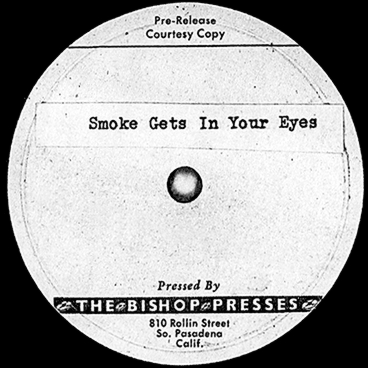
Cornetist and bandleader Red Nichols was born Earnest Loring Nichols in Ogden, Utah, on May 8, 1905. He learned cornet under his father, a college music professor and leader of his family brass band. Throughout the 1920s and 1930s he was one of the most prolifically recorded of the white jazzmen, leading bands that enjoyed great popularity. His most significant recording legacy was the Brunswick recordings he made in the late 1920s under the name Red Nichols and His Five Pennies, a recording ensemble of varying size and lineup that included such musicians as Jimmy Dorsey, Eddie Lang, Miff Mole, Joe Venuti, Jack Teagarden, and Benny Goodman. During much of the 1940s and early 1950s, Nichols played long residencies in West Coast venues, notably El Morocco Club in Los Angeles and Club Hangover in San Francisco.
But Nichols emerged as a legend. In 1959 he played for the soundtrack of the movie, The Five Pennies, which in the typical Hollywood way—it starred Danny Kaye as Red Nichols—was loosely based on his life. Nichols found new popularity, and toured Europe in 1960 and 1964. He died in Las Vegas, on June 28, 1965.
Nichols sources: John Chilton, Who’s Who of Jazz: Storyville to Swing Street (Philadelphia: Chilton Book Company, 1972): 275-76; Tom Lord, The Jazz Discography, Volume 16 (West Vancouver, B.C.: Lord’s Music, 1997): N243-258.
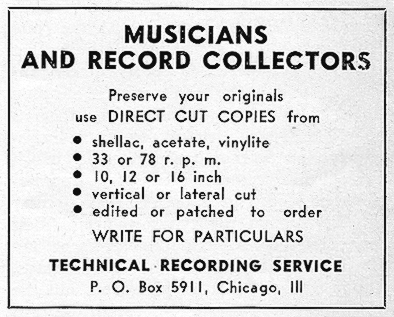
A little while after the Red Nichols session, S D went into temporary hiatus. As Steiner would later explain, "In the fall of 1944 with record pressing at its highest output, and, as a result of shortages, lowest quality, since the turn of the century, S. D. Records suspended activity to await the availability of a prideful type of disc" ("Records to Burn," The Jazz Record, September 1946, p. 5). The company had released 2 78s in its 5000 series and 5 in its 100 reissue series by the middle of May 1944, though we are pretty sure there was some additional production of demo copies.
In February 1945, it was announced that Steiner had bought out Hugh Davis’s share in S D. Davis apparently had lost interest in the partnership. As George Hoefer reported, "Davis has other record activities not conducive to his continuing with S D." Steiner later stated that "Hugh Davis opened his Technical Recording Service, offering fine acetate copies of out-of-print records, non-commercial transcriptions, private recordings and off-the-air shots. It was expedient then for me to purchase his interest in S. D. and await the New Day" when the company could get more records pressed with reasonable quality ("Records to Burn," p. 5).
A brief item on Technical Recording Service appeared in Down Beat on May 21, 1947. It promised "all types of services... including direct-cut copying of valuable collector's titems, copies by re-recording, editing and patching of copies. The latter allows for copying certain choruses only and patching portions of one or more records together on a single plate. Concert 'air shots' are also available."
Hugh Davis would die way too soon, in 1948. He was survived by his wife Nina and a son, Bill. Steiner would later marry Nina.
Meanwhile, the lull in S D's operations dragged on. Steiner would announce impending releases, then they would fail to appear. In George Hoefer, Jr.'s column of July 1, 1945, Steiner reported that he would be releasing the results from a live recording he and Davis had made at the H & T Tavern in 1941, featuring trumpeter Punch Miller and drummer Clifford "Snags" Jones. Granted, all that he promised was that the sides would appear "sometime in the future." We aren't too sure when. The John Steiner Collection, now at the University of Chicago Library, has finished, printed labels for two Punch Miller singles, S D 509 and 510. But we have not seen the actual records. Any that Steiner ordered must have been pressed by Bishop between 1948 and 1950, in what he called "experimental lots": 20 or 25 of each. Four of the six 1941 sides showed up in 1952 as on side of a 10-inch LP, CJS 102 on Steiner’s revived Paramount imprint.
Steiner had become preoccupied with the extensive work he was doing at the Uptown Playhouse Theater (1225 North LaSalle at Goethe). Initially he was called in to fix the group's recording equipment:
The Uptown Players, directed by James Bradley-Griffin, a flamboyant theater character of the wild Woolley-Barrymore genre, had purchased a marvelous building for their activities including work rooms, a recording studio, class rooms, and a 500-seat theater. Within the Players' first few months' occupancy, as a result of inexpert handling, the recording mechanism, radios and phonographs had gone out of adjustment. The group was thoroughly discouraged with their own talent at mechanics and electronics and were casting about for an operator. Davis and I edged in and salvaged a good recording unit and rebuilt the acoustics of their studio.
At a moment when the job was finished and Griffin beamed appreciation (his glow possibly heightened by a quart of ale) I arrived at an agreement with him for my services as a recording operator and janitor of electronics in exchange for a basement room in which to store [a couple of large record collections], as well as a large stock of my own and a residue of S. D. left-overs which had begun to bulge the original S. D. Studios at 104 East Bellevue. The arrangement suited both of us ideally and after a few months I was given several large rooms in the theater to refurbish as an apartment for myself in order that the Players could offer 24-hour recording service. ("Records to Burn," p. 5)
With 5 pianos in playable condition, several record players, radios, and even portable recording equipment available, the theater evolved into a major hangout for traditional jazz musicians and fans. In the July-August 1945 issue of the Record Changer, Steiner actually gave 1225 North Lasalle as the new address for S D.
As though all of this informal activity wasn't enough, Steiner branched out into public concerts. He organized a series of "jazz musicales" for the first and third Sunday afternoons of each month during July and August 1945 at the Uptown Playhouse Theater . His first session featured Bud Jacobson’s Jungle Kings. While Down Beat columnist Don C. Haynes was unimpressed by the group as a whole, he lauded the work of pianist Tut Soper and guitarist Jack Goss. In August, Steiner sponsored the Jimmy Noone Memorial Concert at the Uptown Playhouse, which featured a band consisting of Darnell Howard (clarinet), Boyce Brown (alto sax), Baby Dodds (drums), Gideon Honoré (piano), Jack Goss (guitar), Tut Soper (second piano), and Pat Pattison (bass). In addition, Steiner was doing a bunch of recording at the Playhouse.
Bud Jacobson (cl -1, p -2, ts -3); Volly De Faut (cl -4, d -5); Darnell Howard (cl -6); Dave North (p -7); Mel Grant (p -8); Jack Goss (g -9); Frank Lehman (b -10).
Uptown Playhouse Theater, Chicago, June 1945
| Cherry -2, 4, 9, 10 | unissued | ||
| Fast Blues -1, 5, 7 | — | ||
| High Society -3, 4, 6, 8, 9, 10 | — |
These three entries are taken from Lord's Jazz Discography. The first two are dated June 1945 while the third is dated 1945 with no location noted. All are attributed to "Steiner Davis." Are the masters still extant?
Bud Jacobson (ts); Johnny Mendel (tp); Warren Smith (tb); Volly De Faut (cl); Tut Soper (p); Jack Goss (g); Jim Lannigan (b); Claude Humphries (d).
Uptown Playhouse Theater, Chicago, July 1, 1945
| NOS601 | Digga Digga Do (Part 1) | While Label 17040 | |
| NOS601 | Digga Digga Do (Part 2) | White Label 17040 |
This item apparently survived. All information from Lord's Jazz Discography; has anyone seen the White Label release?
Lord lists three other unissued sessions for Bud Jacobson, dated March 1944, 1945, and 1946, but they are either credited to the Signature label, or merely cited as unissued without a label affiliation, so we have not them here.
The concerts ended when Steiner found himself in a spot of trouble with the Musicians Union. Reported Jazz Session editor John T. Schenck, "John Steiner, the person responsible for some very fine jam sessions in Chicago, ruined his chance for putting on future sessions, and possibly chances for others to stage jam sessions, by trying to pull a ‘fast one’ on the musician’s union by using a mixed band, avoiding to pay leader and stand-in money, and so on. ‘Know-it-all’ Steiner’s blunder will make it twice as difficult for the next person interested in staging a hot jazz concert or jam session." This kind of nastiness, unfortunately, was typical of Schenck, and Steiner never contributed another word to Jazz Session. Note the comment on the "mixed band." Steiner's trouble was with Local 10, the segregated White local of the Musicians Union. But Local 208, which had its own turf to guard, wasn't the most supportive of racially mixed bands at the time.
Steiner's own account is worth contrasting with Schenk's:
On Sunday afternoons in the summer of 1945 we held jam sessions in the theater, attracting with eight and ten-men bands capacity houses which allowed us to pay the men well over scale for their participation. But to pay beyond agreement proved inexpedient generosity, for the Petrillo hoods concluded that we must be making millions and thereupon assessed us $120.00 for the so-called standby charge, an infamous fee set aside for Union electioneering "benefits." Another so-called ruling which the Petrillo boys invoked included an assessment of 10% of the price of the band for using Tony Parenti, who carried only a traveling card, not local membership. We simply went broke; Union greed snuffed us out before the summer was out. ("Records to Burn," p. 6)
The only profit from the sessions was $19.90 out of the soft drink concession. Steiner did note that after he discontinued his sessions other trad enthusiasts formed the Chicago Hot Club, which was able to make a better deal with the Musicans Union.
After hotfooting it out of concert promotion, Steiner launched Jazz Record Seminars, which met every two weeks during the winter of 1945-1946. In 2 hour sessions, 20 or 30 records were played, with commentary from a panel of 3 or 4 experts. Musicians as well as record collectors attended regularly.
On top of the scheduled activities, informal sessions were going on just about constantly. One "jamboree" brought out no less than 27 of the local "hot boys," who according to Steiner produced 45 minutes of recordings. On that occasion, trumpeter Lee Collins, alto saxophonist Boyce Brown, clarinetists Darnell Howard and Volly DeFaut, no fewer than five pianists (Gideon Honoré, Tut Soper, Jack Gardner, Mel Henke, and Chet Roble), and drummer Jim Barnes were among the contributors.
Sources used: George Hoefer Jr., "The Hot Box," Down Beat, 15 February 1945, p. 11; George Hoefer Jr., "The Hot Box," Down Beat, 1 July 1945, p. 11; Don C. Haynes, "Jazz Struggles for Survival in Chicago," Down Beat, 15 July 1945, p. 4; George Hoefer Jr., "The Hot Box," Down Beat, 15 August 1945, p. 11; [John T. Schenck], "Steiner Sessions Fold Up," Jam Session 9 (September-October 1945): 26; John Steiner, "Records to Burn," The Jazz Record, September 1946, pp. 5, 6, 17.
While Steiner was recording regularly at the Playhouse, he must have intended the next session for release on S D, because he got George Hoefer to announce it in print.
Bert Patrick (as); Red Norvo (p); Jack Goss (g); Josh Billings (suitcase); Jim Hall (d).
Uptown Playhouse Theater, Chicago, January 1946
| Confessin’ | unissued | |
| Exactly like You | — | |
| I Talk about the Weather | — |
George Hoefer, in his February 11, 1946 "Hot Box" column, reported these titles in his rundown of "recent waxings." Apparently Steiner never released the titles; Lord cite them as unissued. Lord indicates that Norvo was playing vibes, but Hoefer lists him on piano. This grouping of musicians arose out of concerts Steiner was presenting at the Uptown Playhouse Theater. During intermissions at the Jimmie Noone Memorial Concert and the Baby Dodds Riverboat Band concert, Steiner featured performances by a revived vaudeville act, named the Mound City Blue Blowers after the legendary groups led by Red McKenzie. Steiner's reincarnated Blowers consisted of Frank "Josh" Billings playing a suitcase with whiskbrooms, Tut Soper on piano, and Jack Goss on guitar. According to Steiner, the same trio appeared on many informal sessions at the Uptown Playhouse, playing from 10 or 11 pm to daybreak.
It's hard for us to trace Bert Patrick's movements, because he rarely worked as a leader. On March 15, 1945, he filed an "indefinite" contract with Local 208 for a gig at The Irish Village, followed up by another indefinite contract on June 7. In November 1946 Bert Patrick was playing in Hillard Brown’s six-piece band at Joe’s Deluxe Club.
In 1954, Bert Patrick, now playing tenor sax, was in the studio band on several vocal sessions for a new small label called Drexel. The company's first session featured a doowop group, the Gems, singing "Talk about the Weather," which, in turn, was credited to Caldwell and Patrick (Les Caldwell was one of the label's owners). Bert Patrick appears to have been involved with Drexel for about a year; in 1955, he was replaced on the company's sessions by Johnny Houser. His last composer credit on Drexel was to a song titled "Atlantic Boardwalk," which was sung by Dave Turner.
Bert Patrick and Soper/Goss/Billings sources: George Hoefer Jr., "The Hot Box," Down Beat, 11 February 1946, p. 11; John Steiner, "Records to Burn," The Jazz Record, September 1946, pp. 5, 6, 17.
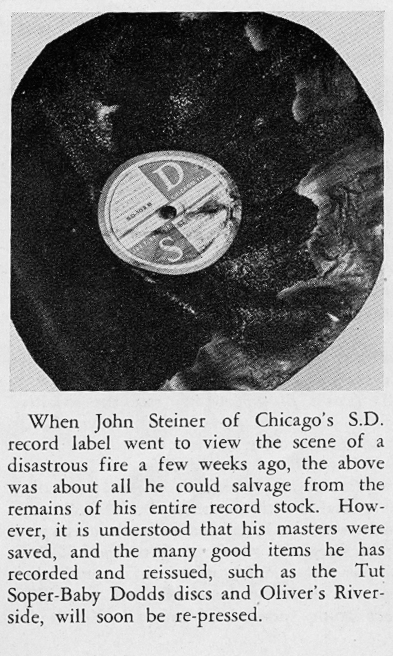
There was another significant hiatus in Steiner's activities after a disastrous fire hit the Uptown Playhouse Theater on April 20, 1946. In his rueful post-mortem, "Records to Burn," he noted that the fire began as the Players were finishing the third act of "You Can't Take It with You."
It reduced the building to a shell. "Along with theater properties were consumed my library and clothes, furniture and office equipment, substantially all of the thousands of records racked in the phono-storage room, the recording studio (more destroyed by inundation than by fire), and every piano in the place, including my upright autographed with the sharp corner of a screw-driver by a host of visitors from Yancey to Slam." (p. 6).
Along with pressings of previous S D releases (but fortunately not their masters) Steiner lost no less than 150 unissued sides by Jack Gardner and his groups (Steiner refers to Gardner as the "musical director for S. D. enteprises since 1941"), 20 sides by groups led by Boyce Brown, a few by Frank Melrose, and location recordings by Gideon Honoré, Zinky Cohn, Punch Miller, Bobby Hackett, Joe Sullivan and Jimmy Yancey, along with many disks recorded from radio broadcasts by big name jazz artists.
Taking the chemist's analytical attitude, Steiner noted that when the 78s were inundated, the labels peeled right off the records pressed during World War II while sticking fast to the pre-war Decca, Columbia, and Victor product. "Wartime shellac compositions blistered upon long contact with dirty water and they became raspy under the needle... A few records of recent pressing, including some Savoy, Philo, and Keynote, after five days immersion, crumbled like clay pies, presumably due to solution of some element in their composition." (p. 17)
"There may be some gain from this experience, especially if this story carries a moral. Records are not to be stored in inflammable buildings. Records are to be copied and the copies widespread" (p. 6).
Sources on the fire: The Jazz Record, June 1946, p. 11; John Steiner, "Records to Burn," The Jazz Record, September 1946, pp. 5, 6, 17.
No doubt helping his recovery from the fire, Steiner was able to get in another recording session. On September 30, 1946, he conducted a marathon outing involving tenor saxophonist Bud Freeman and alto sax player Bill Dohler; Jack Gardner and Tut Soper took turns at the piano bench. Three S D 78s were drawn from it; they were released in March 1947, marking a return to activity for the label.
As a warmup to the September 30 outing, Steiner recorded a concert at the Opera House on September 1 (at least this is the date that Steiner attached to the recordings later on). We don't know the full lineup, but Bud Freeman was featured as a member of a quartet led by pianist Paul Jordan. Two sides were eventually released, though not until Steiner began producing LPs in the early 1950s. We are including them here for completeness.
Paul Jordan (p); Bud Freeman (ts); prob. Mike Rubin (b); prob. Frank Rullo (d).
Opera House, Chicago, September 1, 1946
| C9146-13 | Blop Boose | Paramount CJS105, Classics [Fr] 975 | |
| C9146-17 | Blue Lou | Paramount CJS105, Classics [Fr] 975 |
We got the personnel and the matrix numbers from the Bud Freeman listing in Lord's Jazz Discography. Paramount CJS105 was a 10-inch LP titled Panorama under Bud Freeman's name; Steiner released it in 1953.
Two sides by what was probably the same Paul Jordan Quartet appeared in the Fall of 1946 on Gold Seal 402. These carry matrix numbers in the UB 2000 series from United Broadcasting Studios and appear to have been recorded in September 1946. Precisely because of the UB numbers, however, they do not appear to be from the Opera House concert, as Lord claims in his Bud Freeman section. And Gold Seal identified Paul Jordan as the leader, although Bud Freeman was mentioned on the labels. (There is, in fact, an incomplete listing of the same session in Lord's Paul Jordan section.)
Classics 975 is a French CD released in 1997 under the title Bud Freeman 1946.
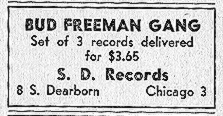

Bud Freeman (ts); Bill Dohler (as); Jack Gardner (p); Jim Lannigan (b); Jim Barnes (d).
Chicago, September 30, 1946
| SD93046-3-1 | Taking a Chance on Love | S D 504 A, Paramount CJS105, Classics [Fr] 975 | |
| SD93046-5-1 | You Took Advantage of Me | S D 504 B, Paramount CJS105, Classics [Fr] 975 | |
| SD 93046-18-1 | Ribald Rhythm | S D 506 A, Paramount CJS105, I Giganti del Jazz [It] GJ34, Europa Jazz EJ 1027, Classics [Fr] 975 |
The copies of S D 504 that we have seen bear the familiar embossing that indicates they were pressed by Bishop. Unlike some other S D's that suffered long delays before release, S D 504, 505, and 506 got moved right along. On December 16, 1946, Steiner wrote to The Bishop Presses from 154 East Ontario street, "Labels are enroute for the our first six sides to be processed and pressed by you." Master numbers, label numbers and titles were provided for all 3 78s. "We shall appreciate fyour every effort to speed test pressings." On January 4, 1947 (shipping date misrendered as 1946), Bishop billed Steiner for over 800 copies of 504 and 505, and 955 copies of 506, at 23 cents a pressing. These were the biggest pressing runs that Steiner is known to have ordered from Bishop; he sent the company a quantity of preprinted labels and asked for as many pressings as labels. Typically the numbers for a particular single were between 2 (really) and 300 copies.
Of all the Bud Freeman sides released by Steiner, S D 504 got the most favorable mention by the Down Beat reviewer, who was not the ever-pliable John Lucas. It didn't hurt that "You Took Advantage of Me" was an old favorite of Freeman's; he had given it a memorable performance in 1938 for Commodore, and would record it on several other occasions. Awarding the 78 three of the four possible quarter notes, the reviewer noted that both numbers swung "consistently with both reed men attempting good consistent improvisation."
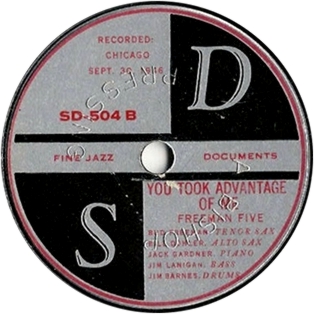
"Ribald Rhythm" on S D 506 got a two-note review and the Down Beat scribe noted that the number was actually "Between the Devil and the Deep Blue Sea."
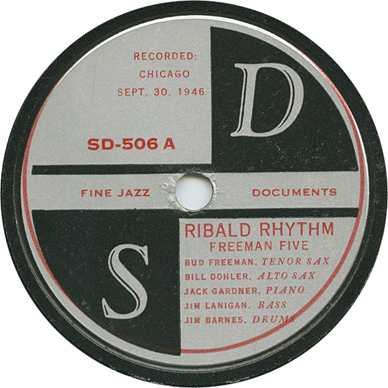
John Lucas praised the sides in his "Jazz on Record" column in the Record Changer (April 1947), lauding Steiner for a "novel and stimulating idea," that is, using alto and a tenor sax as the "whole melody section in collective improvisation." He said S D 504 found Dohler on alto and Freeman on tenor "weaving some of the most complex patterns conceivable, and with complete spontaneity."
The Freeman 78s on S D 504 through 506 remained in stock until at least 1952, when a booklet included with the first 10-inch Paramount LP release still advertised them for sale.
Finally, though, they were superseded by a 10-inch LP that collected the 6 tracks from this session and 2 from September 1. Paramount CJS105 was called Panorama under the artist name Bud Freeman; Steiner released it in 1953.
Classics 975 is a French CD released in 1997 under the title Bud Freeman 1946.
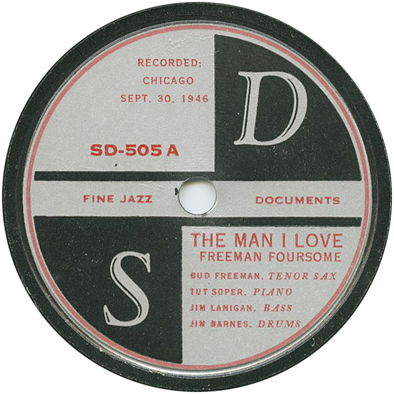
Bud Freeman (ts); Jack Gardner (p); Tut Soper (p-1); Jim Lannigan (b); Jim Barnes (d).
Chicago, September 30, 1946
| SD-93046-11-1 | The Man I Love -1 | S D 505 A, Paramount CJS105, Classics [Fr] 975 | |
| SD 93046-18-1 | Ontario Barrel House* | S D 506 B, Paramount CJS105, I Giganti del Jazz [It] GJ34, Europa Jazz [It] EJ 1027, Classics [Fr] 975 |
Lord gives the artist names as Bud Freeman Quintet and Bud Freeman Quartet. We are using the names as they appeared on S D 504, 505, and 506. See above for the pressing history on these three; Steiner ordered 800 or more copies of each in mid-December 1946 and had them in his hands in January 1947. Paramount CJS105 was called Panorama and the artist's name there was plain old Bud Freeman on the jacket, Bud Freeman and the Chicagoans on the labels; Steiner put it out in 1955.
Lord also identifies 3 of the tracks that appeared on the 10-inch LP as different takes from those released on S D. But according to Bud Freeman expert Tom Hustad, no alternate takes have survived, and Steiner's Paramount LP was a straight reissue of the S D sides (with the two from September 1 added).
Classics 975 is a French CD released in 1997 under the title Bud Freeman 1946.
The Down Beat reviewer gave both numbers two quarter notes out of a possible four. "The Man I Love" was criticized for poor mike placement and Freeman’s "unsteady" tone, and "Ontario Barrel House" was faulted for Freeman’s "honkey" tone and Gardner’s right hand lacking "technical freedom." Lucas, on the other hand, thought that "Ontario Barrel House" and "Ribald Rhythm" (S D 506) was the best of the three couplings.''
According to Hoefer, "Ontario Barrel House" is named for the street where the apartment that Steiner and Gardner shared was located. We checked the phone books from the period and could not find either Steiner or Gardner at that address. But they had left Bellevue Place, and the apartment that Steiner maintained at the Uptown Playhouse had been destroyed in the fire. In fact, Steiner's letter to Bishop on December 16, 1946 was mailed from 154 East Ontario. In January 1947, received a bill from Bishop at the same address. He seems to have moved to 8 South Dearborn before June 1947.
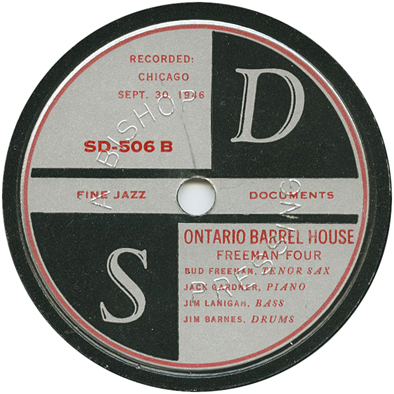
Bud Freeman was born Lawrence Freeman, on April 13, 1906. He is one of the famed members of the Austin High School Gang, and helped put Chicago on the map as a jazz center in the 1920s, playing with his schoolmates in the Blue Friars and then the Wolverines. He began on the C Melody sax in 1923, and switched to tenor sax in 1925. During 1926-27, he played in various Chicago bands, and then moved with Ben Pollack’s band to New York City in 1928. In 1929 Freeman was touring with Red Nichols. Early white jazz was gimmicked up with sound effects, and Freeman is credited with being one of the first white tenor sax players to free himself from the novelty approach (black tenorists, led by Coleman Hawkins and Prince Robinson, also had to escape the pull of the once-omnipresent "slap-tonguing" technique). During the 1930s, Freeman recorded extensively with such bands as Paul Whiteman, Tommy Dorsey, and Benny Goodman. He established his own band in the late 1930s, performing in a style that combined Swing with traditional Chicago style. From 1943-45, Freeman was in a service band, and upon becoming a civilian in the summer of 1945 formed his own band. He was under contract to Majestic for a year, but the experience was unsatisfactory because his band was mainly called on to back vocal groups, producing several records with no real jazz content.
As one of the titans of early jazz, Freeman was frequently recorded during the 1940s and 1950s. He had a long residency in Chicago at his own Gaffer’s Club in 1949. In the late 1970s he was living in London, but returned to Chicago when invited to appear in the Chicago Jazz Festival in 1980. He retired from performing in 1989, and died in Chicago on March 15, 1991.
Freeman sources: John Chilton, Who’s Who of Jazz: Storyville to Swing Street (Philadelphia: Chilton Book Company, 1972): 125; R. Bruce Dodd and Jerry Crimmins, "Lawrence ‘Bud’ Freeman, Chicago-Style Jazz Legend," Chicago Tribune, 17 March 1991.
Bill Dohler (as); Tut Soper (p); Jim Lannigan (b); Jim Barnes (d).
Chicago, September 30, 1946
| SD93046-17-1 | Blue Lou | S D 505 B [edited], Paramount CJS105 |
The copies of S D 505 that we have seen were pressed by Bishop in South Pasadena, California. See above for the pressing history on S D 504, 505, and 506, which were done by Bishop in late December 1946 or early January 1947 (Bishop's invoice to Steiner was dated January 4, 1947).
Dohler's opening statement (running to 22 seconds) was edited out of the original release, which starts with Soper's first piano solo. On the Bud Freeman LP (Paramount CJS 105), the track is complete.

The Down Beat scribe, "Mix," who reviewed the number with its flip, "The Man I Love," gave the number two notes out of 4, and faulted poor mike placement that kept Lannigan’s bass from coming through. (In fact, Barnes' bass drum is louder than the string bass.) Similar to his comments on Gardner, he appreciated Soper’s enthusiasm, but thought he needed more "technical surety." Lucas, in contrast, was more taken with Gardner and Soper than "Mix," gushing, "these records are priceless if only because of the electrifying work of Soper and Gardner."
The entire package of 3 S D releases was reviewed in George Avakian's column in the May 1947 issue of The Jazz Record. Alluding to the long pause since the last S D release, Avakian referred to the 78 as the company's "first post-war release in the form of three records featuring the tenor sax of Bud Freeman and the alto ditto of Bill Dohler... with a three-piece rhythm section" (p. 7). It really was the first postwar release, the product of Steiner's first pressing order with Bishop. Avakian's assessment of the music was that the 78s "have a distinct jam-session flavor, and should appeal most to those who get a great kick out of these affairs. They are two-fisted improvisations, emotional rather than calculated, on familiar standards" (p. 8). Avakian thought that "Ribald Rhythm" wasn't quite up to the same level as the others, because the (unnamed) standard on which it was based "never was much of a jazz vehicle" (p. 8).
Bill Dohler had been performing since the late 1920s, when he got together with his former classmates from Lake View High on the far north side of Chicago—Lake View High Gang doesn’t have the same ring as Austin High Gang. He bounced from band to band, playing for example in the 1930s Earl Hoffman band out of Louisville.
Avakian commented that "Dohler, who is new to me, and probably a stranger to most readers, too, plays quite like Bud, and on the sides in which they improvise duets it's hard to tell which instrument is which" (pp. 7-8).
We know hardly anything about Bill Dohler's later activities. Bill Dohler also played alto sax in an octet led by Paul Jordan that recorded for Gold Seal in September 1946. This was a studio recording at United Broadcasting; the Paul Jordan Octet single on Gold Seal 403 carries matrix numbers in the UB2400s. Bud Freeman did not participate in the octet session, which featured Boyd Rolando as the tenor saxophone soloist.

S D 505 remained in Steiner's catalog until at least 1952. The entire session, Dohler's solo feature included, was reissued on a 10-inch LP in 1953. Paramount CJS105 was called Panorama under the artist name Bud Freeman and the Chicagoans.
The decision to exclude Bill Dohler's side from a Bud Freeman compilation (Classics 975) had its logic, but it has left this one excellent performance without any reissues on CD.
Sources Used: George Hoefer Jr., "The Hot Box," Down Beat, 26 February 1947, p. 12; Mix, "Diggin’ the Discs," Down Beat, 26 March 1947; John Lucas, "Jazz on Record," The Record Changer 6/2 (April 1947): 10; George Avakian, "Records—Old and New," The Jazz Record (May 1947), pp. 7-8; Booklet included in Paramount CJS101, released in 1952, courtesy of Konrad Nowakowski.
In addition to the 5000/500 series, S D put out a special 78 Christmas 1946, drawn from a Duke Ellington concert that Steiner had recorded at the Civic Opera House in Chicago. If it was released around Christmas 1946, that made it the first S D release since the fall of 1944; releases in the 500 series would not begin until the spring of 1947. The first sign we've spotted of the Xmas 46 record is a bill from The Bishop Presses on March 11, 1948—for 25 copies. On April 26, 1949, Steiner ordered more copies of the Xmas 46 record, but made it clear that it wasn't a priority ("their [sic] simply experimental lots") and that it could be done on "Flex." or Vinylite at Bishop's discretion.
A second limited edition single release for Christmas 1947, which paired Red Nichols and Cassino Simpson, was far from the last release from S D, because many were substantially delayed. But one side of it was actually recorded in 1947, albeit off the air. Maybe it got super-limited circulation in December 1947, but the first indication we've seen of it is the bill from Bishop on March 11, 1948—25 copies at 20 cents each. A few more were pressed in 1949, as we can see from same letter to Bishop from April 26 of that year, in which Bishop is asked to press it "at your convenience."
A third single appeared in 1949 (maybe for Christmas, but we don't see that on the labels and we haven't found any contemporary announcements). Both sides were taken from the same 1947 broadcast. The last Christmas single is the only S D release to include a "modern" jazz group (in this case, an all-star lineup with Charlie Parker, Dizzy Gillespie, and Lenny Tristano).
The UP prefix to the matrix numbers stood for the Uptown Playhouse Theater, where Steiner ran a recording studio until the theater was destroyed by fire. Perhaps the Christmas 1946 release was actually mastered in the Uptown Playhouse studio. But when it came to the Christmas 1947 release and the 1949 release, the UP prefix was (alas) purely commemorative.
John Steiner recorded Duke Ellington concerts at the Civic Opera House on three different dates, using overhead microphones: March 25, 1945; January 20, 1946; and November 10, 1946. Much of the material from the two 1946 dates, with the November concert featuring special guest Django Reinhardt, is now included in an MHS 2 CD set, Musical Heritage Society 523584W, titled Duke Ellington: The Great Chicago Concerts; Mercer Ellington is listed as the producer, and the CDs were issued in 1994.
In his own discography of the the three S D Merry Christmas 78s (Matrix 21, January 1959, p. 21), Steiner gave March 25, 1945 as the date for "Frankie & Johnnie," which took up both sides of the Christmas 1946 single. In an addendum in the Matrix 29/30 (August 1960), Steiner reiterates the date. And a test pressing from Hugh Davis's shop has the same date typed on both sides.
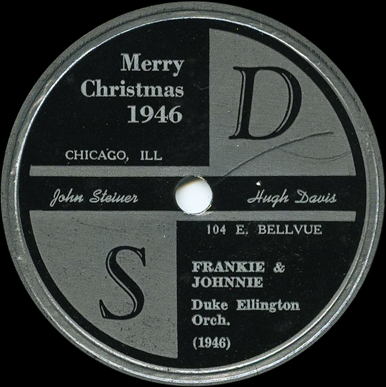
Duke Ellington (p, ldr); Shelton Hemphill (tp); Rex Stewart (tp); Taft Jordan (tp); Cat Anderson (tp); Ray Nance (tp, vln, voc); Joe "Tricky Sam" Nanton (tb); Lawrence Brown (tb); Claude Jones (tb); Otto Hardwick (as); Johnny Hodges (as); Jimmy Hamilton (ts, cl); Al Sears (ts); Harry Carney (bars, cl, bcl); Fred Guy (g); Alvin "Junior" Raglin (b); Sonny Greer (d); Joya Sherrill (voc); Kay Davis (voc); Marie Ellington (voc); Al Hibbler (voc). On -1, just Ellington (p), Raglin (b), and Greer (d).
Civic Opera House, Chicago, March 25, 1945
| Blutopia | unissued | ||
| Midriff | — | ||
| Creole Love Call [KD voc] | — | ||
| Suddenly It Jumped | — | ||
| Frantic Fantasy | — | ||
| I Didn't Know about You | — | ||
| My Heart Sings [JS voc] | — | ||
| The Air-Conditioned Jungle | — | ||
| Black, Brown, and Beige: Work Song | Joyce LP1053A | ||
| Black, Brown, and Beige: Come Sunday | Joyce LP1053B | ||
| Black, Brown, and Beige: The Blues [ME voc] | Joyce LP1053B | ||
| Black, Brown, and Beige: West Indian Dance | Joyce LP1053B | ||
| Black, Brown, and Beige: Sugar Hill Penthouse | Joyce LP1053B | ||
| Black, Brown, and Beige: Emancipation Celebration | Joyce LP1053B | ||
| Things Ain't What They Used to Be | unissued | ||
| Perfume Suite: Sonata | Joyce LP1053B | ||
| Perfume Suite: Strange Feeling | Joyce LP1053B | ||
| Perfume Suite: Dancers in Love [AH voc] | Joyce LP1053B | ||
| Perfume Suite: Coloratura | Joyce LP1053B | ||
| Medley: Sophisticated Lady -1 | unissued | ||
| Medley: Solitude -1 | — | ||
| Medley: I Let a Song Go out of My Heart -1 | — | ||
| Take the "A" Train [Theme & Intro] | Joyce LP1053A | ||
| Blue Cellophane | Joyce LP1053A, Aircheck 29 | ||
| Frustration | Joyce LP1053A, Aircheck 29 | ||
| I'm Beginning to See the Light [JS voc] | Joyce LP1053A, Aircheck 29 | ||
| Presentation of Down Beat Awards | Joyce LP1053A | ||
| The Mood to Be Wooed | Joyce LP1053A | ||
| It Don't Mean a Thing [RN voc] | Joyce LP1053A | ||
| I Ain't Got Nothin' but the Blues [KD, AH voc] | Joyce LP1053A | ||
| Blue Skies | Joyce LP1053B | ||
| Take the A Train [inc] | Joyce LP1053B | ||
| UP 501 UP 502 |
Frankie & Johnnie | S D Merry Christmas 1946, Jazz Society [Swe] AA 545 | |
| Honeysuckle Rose | unissued |
Although there were Jazz Society LPs in the 1970s and 1980s, AA 545 was apparently a 78-rpm single. Further research is needed!
1053A and 1053B were two LPs on the Joyce label, titled One Night Stand with the Duke at the Civic Opera Part One and Part Two. The Joyce label offered a long series of One Night Stand LPs featuring live or broadcast recordings of Swing bands. On Joyce 1053A, the first "Take the A Train" is just "Theme and Intro," and Ray Nance gets the vocal credit on "It Don't Mean a Thing," which Lord lists as an instrumental. "Presentation of Down Beat Awards" goes unmentioned in Lord. Joyce 1053B puts the Al Hibbler vocal credit on "Dancers in Love," not "Strange Feeling" (which is where Lord has it). Also, "West Indian Dance," "Sugar Hill Penthouse," and "Emancipation Celebration," though banded separately, are titled "Three Dances" on the LP. The incomplete "Take the A Train" is included with "Blue Skies" and not separately banded.
The Aircheck LP was titled Duke Ellington: "On the Air" Volume 2 and released in 1981. It included three sides from the broadcast portion of this concert (four if the first "Take the A Train" was included but not separately banded), along with material from the 400 Club in New York City (also 1945) and Ellington's Carnegie Hall concert of 1948.
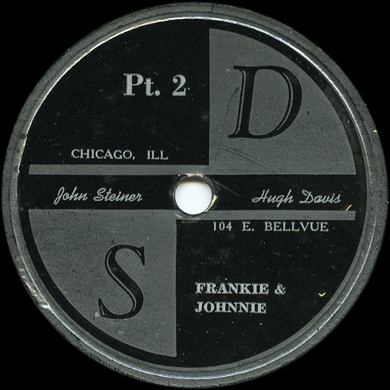
As released by Steiner, "Frankie and Johnny" (to use the standard spelling) runs to 7:45, so it takes up both sides of the S D 78. It features a long piano solo by the Duke, which is what recommended it to Steiner. It also includes a violin solo by Ray Nance and a muted trombone solo by Joe "Tricky Sam" Nanton. "Frankie and Johnny" comes from the portion of the concert that was broadcast (it starts with the first "Take the A Train"), which means that Steiner could have gotten it off the radio; however, the entire concert was recorded.
Some copies of S D Merry Christmas 1946 have corrected the spelling on the title to "Frankie and Johnny" and fill out the name of the band (on both sides) to "Duke Ellington Orchestra." They still give 1946 as the date on one side. These do not show "John Steiner" or "Hugh Davis" in script across the middle of the label, so clearly are from a later pressing.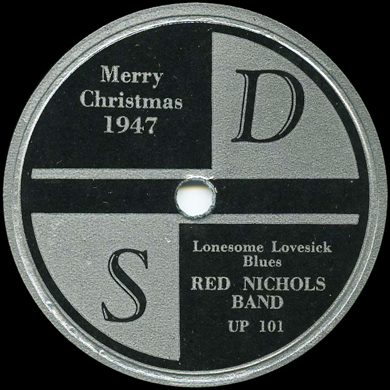
Red Nichols (tp); Lou McGarity (tb); Rosy McHargue (cl, arr); Don Lodice (ts); Joe Rushton (bass sax); Pete DeSantis (p); poss. Thurman Teague (b); Rollie Culver (d).
Radio Broadcast, Ginny Simms Show, Los Angeles, April 18, 1947
| UP 101 DP | Lonesome Lovesick Blues | S D Merry Christmas 1947, Broadway Intermission BR130 |
Lord notes that the S D Merry Christmas 1947 item was a special gift record, issued as a limited edition (he doesn't mention its predecessor from 1946). The DP is what now be the familiar Dike-Polzin monogram, indicating that it was mastered in Pasadena, California. The flip side to Merry Christmas 1947 was a Cassino Simpson recording that Steiner and Davis made back in 1942 (session SD2, above). Broadway Intermission BR130 was an LP called At the Jazz Band Ball.
For more about singer and actress Ginny Simms, who hosted a network radio show in 1947, see our Sonora page.
The Christmas 1947 release was the first S D to include an off-the-air recording. The airshot could have been done by Hugh Davis but was most likely made by Steiner himself (he had been making them for years, but most of his previous collection had been lost in the Uptown Playhouse Theater fire).
Early in 1948, Steiner would switch his priority to reissuing material from the Paramount label. S D releases in the 5000/500 series would drag on into 1949, but only in delayed fulfillment of earlier plans. Steiner threw in one last special release that same year; it consisted of two more off-the-air recordings. As the only S D release to feature a bop performance, it is somewhat of a curiosity.
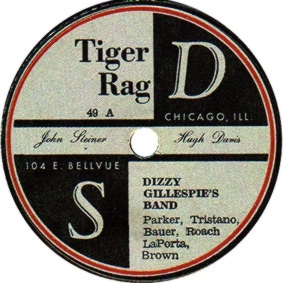
John Birks "Dizzy" Gillespie (tp); Charlie Parker (as); Jon LaPorta (cl); Lenny Tristano (p); Billy Bauer (eg); Ray Brown (b); Max Roach (d)
*"Wild" Bill Davison (cnt); Jimmy Archey (tb); Edmond Hall (cl); Ralph Sutton (p); Danny Barker (g); Pops Foster (b); Warren "Baby" Dodds (d).
Bands for Bonds broadcast, MBS Radio Network, New York City, September 20, 1947
| UP-49-B 57 | Tiger Rag | S D 49 A | |
| UP-49-A 57 | Tiger Rag* | S D 49 B |
On September 20, 1947, the weekly Bands for Bonds broadcast on the Mutual Broadcasting System featured a staged battle between a Dixieland ensemble (which had been resident on the show for months) and a "modernist" aggregation. The battle actually commenced on September 13, when each band played three numbers of its own choosing. On September 20, they were asked to play the same titles (not counting opening and closing themes): "On the Sunny Side of the Street," "How Deep Is the Ocean," and "Tiger Rag." The traditionalists all knew "Tiger Rag" but it was not exactly standard repertory for the boppers; this was probably the only time that Charlie Parker, Dizzy Gillespie, or Lenny Tristano played the venerable tune in public.
John Steiner recorded this show off the air and decided to put both performances of "Tiger Rag" on a special-issue 78. The matrix numbering was provided by Mike Stewart of Green River Records, and confirmed from a copy in Konrad Nowakowski's collection: the A matrix is on the B side, and vice versa. It suggests a continuation of the Christmas issues. There is no Christmas indication, however, and the labels are of the same design that Steiner was using for his 5000/500 series. Also, UP 49 was not pressed at Bishop; there is no Dike-Polzin marking in the vinyl, and the masters were not among those that Deeco (Successor to Dike-Polzin) returned to Steiner in September 1950. An August 1960 entry by John Steiner in the Matrix (29/30) confirmed the broadcast date and the mismatch between the label and trail-off matrix numbers.
Discographies such as Bruyninckx' and Lord's list this session under the title "This Is Jazz," which was used on many of the MBS broadcasts (although apparently not on September 20). The Dixieland group was normally billed as the All Star Stompers. On the battle-of-the-bands shows, with the outspoken traditionalist critic Rudi Blesh as its champion, it went as Rudi Blesh's All Star Stompers. The Bird-Diz-Tristano band was recruited by Barry Ulanov, a vehement proponent of bebop, and billed as Barry Ulanov's All Star Modern Jazz Musicians. As he often did, Steiner came up with his own names for each band.
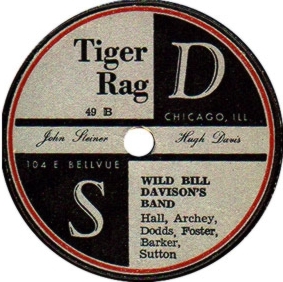
The S D single was the first release for either track. "Tiger Rag" has appeared on many a Charlie Parker compilation since the early 1970s, when ESP-Disk' put it on an LP of Bird's airshots (ESP's LP label misspelled it as "Tiger Rage"). Starting with 1970s LPs on Spotlite and Zim, most of the Bird compilations have included the entire set by Barry Ulanov's All Star Modern Jazz Musicians, but for some reason only "Tiger Rag" from this date has appeared on All Star Stompers reissue packages.
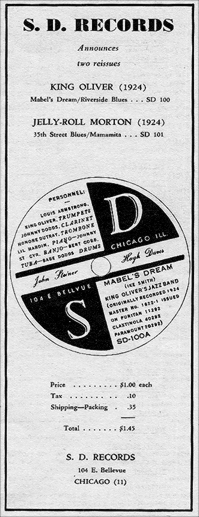
When S D was launched, its first releases were actually reissues from the Paramount label. Steiner and Davis had negotiated with Otto Moeser of the Wisconsin Chair Company, which still owned the moribund Paramount operation, to license and put out sixteen releases. (We will have more to say about Paramount later, when we cover Steiner's purchase of what remained of the company.) The first two of these were S D 100 and 101, which probably came out in January 1944, were first advertised in the February 1944 issue of the Record Changer, and first reviewed in the April 1944 issue of The Jazz Record.
An ad for S D in the May 15, 1944 issue of Down Beat listed S D 100 through 104, as did the company's advertisement in November 1944 issue of The Jazz Record. So it appears that S D 102, 103, and 104 came out in April or May of 1944. And in the August 15, 1944 issue of Down Beat, 100 through 104 were also said to be available as wire recordings. It would be most interesting to know what kind of packaging was used for the wire recordings. The 100 series label on the 78s listed the company’s address, but misspelled the street name as "Bellvue."<
The promise to release 16 78s was somewhat exaggerated. Eleven actually came out, ranging from S D 100 through 110. But one side of 103 had been recorded for Autograph/Rialto, and 105 and 106 were derived from the Edison label, so 8 1/2 releases actually stemmed from the Paramount deal.
The label design of the 100 series was similar to that of the 5000/500 series, so in our discographical entries we've listed the label name as S D.
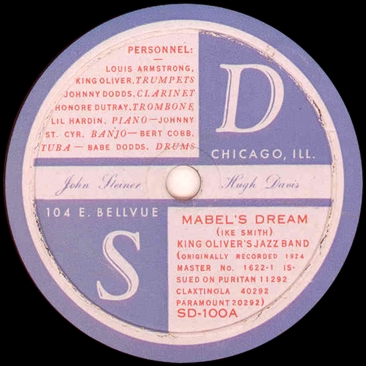
Joe "King" Oliver (cnt); Louis Armstrong (cnt); Honoré Dutrey (tb); Johnny Dodds (cl); Lillian Hardin Armstrong (p); Charlie Jackson (bass sax); Warren "Baby" Dodds (d).
Marsh Laboratories, Chicago, c. December 24, 1923
| SD100A; originally 1622-1 | Mabel’s Dream (Smith) | S D 100 A, Signature 905, Paramount 14014 | |
| SD100B; originally 1624-1 | Riverside Blues | S D 100 B, Signature 905, Paramount 14014 |
The original 78 rpm releases of these titles, all in 1924, were on Paramount 20292, Puritan 11292, and Claxtonola 40292. In 1950, S D 100 would be reissued in Steiner's Paramount revival series as Paramount 14014.
Apparently Steiner and Davis had no idea that Bob Thiele of Signature was planning to reissue this 78—or vice versa—so both reissues came out in early 1944, and ended up being reviewed together by S/Sgt. George Avakian. The takes used on both S D 100 and Signature 905 were the ones that appeared on Claxtonola 40292. As Avakian explained (in his "Records—Old and New" feature, The Jazz Record, April 1944, p. 3), "It's obvious that both outfits used identical Claxtonola originals from which to dub new plates. Oliver-Armstrong specialists will probably tear their hair out over this fact, since most of them have Claxtonola pressings [he refers to Joe Bodine finding a bunch of them]..." As a consequence, neither Signature nor S D picked up the second take of "Mabel's Dream" (just one take of "Riverside Blues" was done at the session).
In his review, Avakian subscribed to a then-prevalent theory, that Oliver's Paramount session took place in March 1923 and therefore predated his first session for Gennett. The dating has long since been revised. According to David Sager in his notes to King Oliver Off the Record: The Complete 1923 Jazz Band Recordings (a 2006 release on CD), the session took place around December 24, 1923. Technical work on the reissue revealed that the sides from this session behaved like electrical recordings, although Marsh Laboratories' efforts, which had begun in 1922, were so early and so crude that they are better described as primitivo-electric.

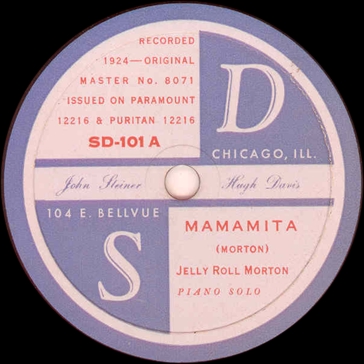
Ferdinard "Jelly Roll" Morton (p).
Rodeheaver Recording Laboratories, Chicago, c. April 1924
| SD101A; originally 8072 | Mamamita (Morton) | S D 101 A | |
| SD101B; originally 8071 | 35th Street Blues (Morton) | S D 101 B |
This 78 was originally released on Paramount 12216 and Puritan 12216; on the Paramount, "Thirty Fifth St. Blues" was the A side. "Mamamita" is a misspelling of "Mamanita" (in turn, a contracted form of "Mama Anita"), named after an old girlfriend of The Roll's.
The studio is identified in the up-to-date online discography for Jelly Roll Morton at http://www.doctorjazz.co.uk/page15.html#diskrec.
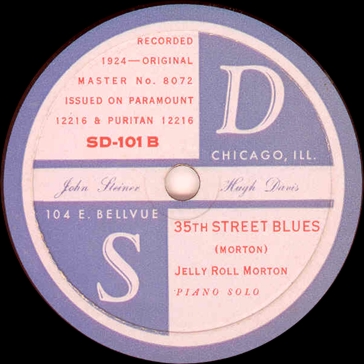
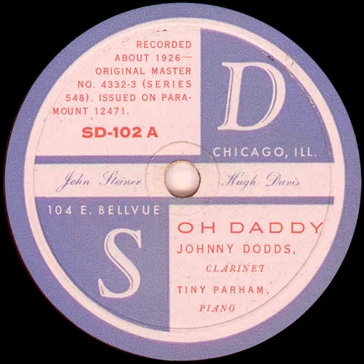
Side A: Johnny Dodds (cl); Hartzell Strathdene "Tiny" Parham (p)
Side B: Laura Rucker (voc); Cassino Simpson (p).
Chicago, c. March 1927
Grafton, Wisconsin, 1931
| CRC9127A, SD102A A; originally 4332-3 | Oh Daddy | S D 102 A, Paramount 14032 | |
| CRC 9128 A, SD102B A; originally L-818-2 | St. Louis Blues* (Handy) | S D 102 B |
The Dodds/Parham side was originally issued on Paramount 12471. In 1950, Steiner reissued "Oh Daddy" as the B side of his last Paramount revival 78, Paramount 14032. (The A side was "Frog-I-More Rag" by Jelly Roll Morton, reissued from S D 103.) Two more duets by Dodds and Parham were cut the next month and released on Paramount 12483, but not used by S D.
The Simpson/Rucker first appeared on Paramount 13075, in the waning days of the label.
The CRC numbers show that the Chicago Recording Company was mastering these S Ds, beginning with 102. Any S D product with CRC numbers dates from 1944.


Side A: Ferdinand "Jelly Roll" Morton (p)
Side B: Laura Rucker (voc); Cassino Simpson (p)
Side A: Marsh Laboratories, Chicago, April or May 1924
Side B: Grafton, Wisconsin, 1931
| CRC 9148, SD 103A A; originally 534 | Frog-I-More Rag (Morton) | S D 103 A, Paramount 14032 | |
| CRC 9129, SD 103B A; originally L-817-1 | Little Joe* | S D 103 B |
"Frog-I-more Rag" is a solo piano performance by Morton. Around 1940, Steiner had found an unlabeled test pressing in a Chicago junk shop. Through consulting with Jelly Roll Morton experts (who were cited right on the label of S D 103!), he determined that it was a Morton performance from the 1920s. (See our Session page for details). It was, in fact, an unreleased recording that The Roll made for the tiny Autograph label or even tinier Rialto label (the original matrix, not included on the test pressing, turns out to be number 534). "Frog-I-More" was recorded with the Marsh Laboratories primitivo-electric process (see the entry for S D 100 above). On its very first commercial release, S D 103A, it sounds pretty respectable for a 1924 recording made for a tiny label, and not at all like the Morton solo sides for Gennett, which some people used to think it derived from.
See http://www.doctorjazz.co.uk/page15.html#diskrec for up to date information about the recording session. At this time the Marsh Recording Laboratories were located in Suite 625 of the Kimball Building at 306 South Wabash Avenue in Chicago.
"Little Joe" was initially released on Paramount 13075.
Steiner and Davis paired the Morton and Johnny Dodds sides with two Laura Rucker Paramount sides from 1931. The source of their interest was Cassino Simpson’s piano accompaniment (although an accomplished pianist herself, Rucker concentrated on her singing for the session). In fact, the CRC numbers from Chicago Recording Company show that the two Rucker/Simpsons were mastered in the same batch.
The impending release of S D 103 was announced by George Hoefer, Jr., in his Down Beat column "The Hot Box" (April 1, 1944). In 1950, Steiner reissued "Frog-I-More Rag" on the A side of Paramount 14032, which would be his very last Paramount revival 78.
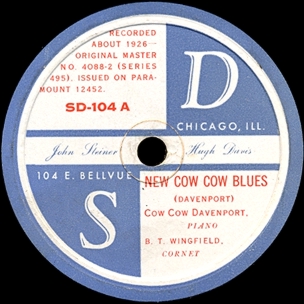
Charles "Cow Cow" Davenport (p); B. T. Wingfield (cnt -1); Leroy Pickett (vln -2).
Chicago, c. January 1927
| CRC 9130 A, SD104A A; originally 4088-2 | New Cow Cow Blues (Davenport) -1 | S D 104 A | |
| CRC 9131 A, SD 104B A; originally 4095 | Stealin' Blues (Davenport) -2 | S D 104 B |
Our information on S D 104 comes from a copy in Konrad Nowakowski's collection. The original issue was on Paramount 12452. Chicago Recording Company did the mastering on these.
Our session information is drawn from Dixon, Godrich, and Rye. The two sides of S D 104 were part of a 4-tune session; Davenport didn't sing on either of the sides selected by Steiner. It was his first and only session for Paramount (preceded only by two tunes from May 1925 that were never released by Gennett). Davenport went on to record for Brunswick/Vocalion and Gennett (1928-1930) and Decca (1938).
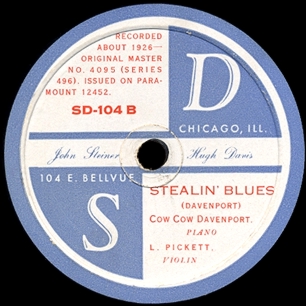

Besides S D 102, 103, and 104, S D 5000 and 5001 were originally mastered (in 1944) by Chicago Recording Company.
Because John Steiner was dissatisfied with the quality and availability of pressings during wartime, and he was successively preoccupied with buying out Hugh Davis and operating his recording/rehearsal/performance complex at the Uptown Playhouse Theater, there was a long pause before the S D 100 series resumed. From the numbering, we may surmise that it was supposed to pick up with S D 105 and 106, which were mastered by Hugh Davis, but for one reason or another these were put aside. S D 107 and 108 beat them to market. S D 109 and 110, which we know less about, may have done so as well.
Loring "Red" Nichols (cnt); Mifflin "Miff" Mole (tb); Jimmy Dorsey (cl, as); Alfie Evans (as); Arthur Schutt (p); Joe Tarto (tuba); Vic Berton (d).
New York, November 10, 1926
| SD 105A; originally 11291-A | Hurricane (Mertz) | S D 105 A | |
| SD 105B; originally 11292-B | Black Bottom Stomp (Morton) | S D 105 B |
We got our information on this release from a copy in Tom Kelly's collection. Our impression is that S D 105 and 106 were planned years before the fact, because the labels still give 104 S. Bellvue [sic] as the address and include Hugh Davis's name. On July 8, 1947, Bishop billed S D for 25 copies each of S D 105 through 110. These cost 30 cents each because of the short runs (and, as we shall see, Steiner would make a change to 110). So a pressing of S D 105 was available in December 1947, when it was first cited in print as a "future" release. On April 26, 1949, Steiner ordered bigger runs of S D 105 and 106 (along with two of his Paramounts and Dublin's 1). These were to be pressed according to the number of labels Steiner sent, and we don't have the invoice for them, but he indicated that he wanted them done on shellac "in a hurry." Here, finally, was a commercial sales/mail order run. S D 105 was first mentioned in one of Steiner's advertisements in the November 1949 issue of the Record Changer. And it received its first review in February 1950. S D 105 is also listed in the 1950 catalog for Steiner's Paramount label.
According to Tom Lord's Jazz Discography, these two sides were cut at Red Nichols' second session as a leader, not long after The Roll's Victor recording of "Black Bottom Stomp" was released. (Since Edison had been long out of business, they must have been really hard to find in the mid-1940s).
The original issue was Edison 51878, which was recorded, mastered and pressed using the "hill and dale" or "vertical groove" technique. Steiner didn't put "Edison" next to the number—does that mean that the reissue was unauthorized? Some years later, when he released Paramount RS201, he stated that he had licensed the (different) Edison sides that he used on the LP.
According to a brief item by Woody Backensto ("Small Change," Record Research 102, November 1969, p. 6), Edison recorded three takes (A, B, and C) of each tune. Both A and B takes of "Hurricane" are known to have been used for different pressings of Edison 51878, but Steiner recollected that Hugh Davis used a 78 in his own collection (with the A take) when he mastered the side for S D. Both the B and the C take of "Black Bottom Stomp" were issued on Edison 51878, but Davis used his copy of the 78 with the B take. A later reissue of the sides on Riverside LP 1048 would use the B take of "Hurricane" and the C take of "Black Bottom Stomp."
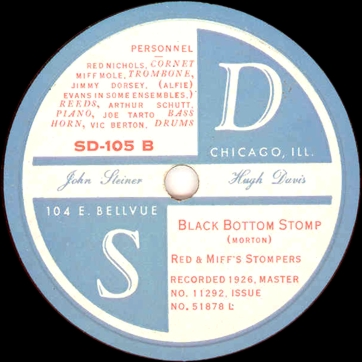
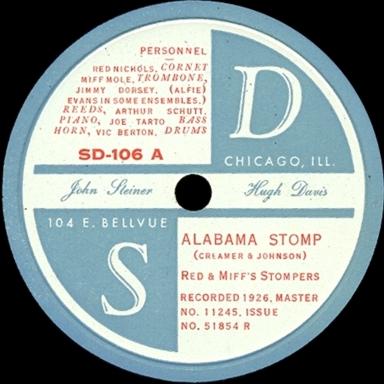
Red Nichols (cnt); Miff Mole (tb); Jimmy Dorsey (cl, as); Alfie Evans (as); Arthur Schutt (p); Joe Tarto (tuba); Vic Berton (d).
New York, October 13, 1926
| SD 106 A DP1; originally 11245-C | Alabama Stomp | S D 106 A, Riverside 1048, Vertical Jazz 5829-8 | |
| S D 106 B DP1; originally 11246-A | Stampede | S D 106 B |
Our information closest to the source for this one is Steiner's 1950 Paramount catalog. Like its predecessor, S D 105, 106 was planned in 1944—definitely before Hugh Davis sold Steiner his share of the company in February 1945. It was pressed in 25 copies (shipped to Steiner from Bishop on July 8 1947) and referred to in print as a future release in December 1947. The labels show the 104 E. Bellevue address. But the first advertisement to mention S D 106 ran in the Record Changer for November 1949. Steiner ordered the first real production run from Bishop on April 26, 1949. "DP" designates the monogram of Dike-Polzin, later known as Deeco, in Pasadena, California.
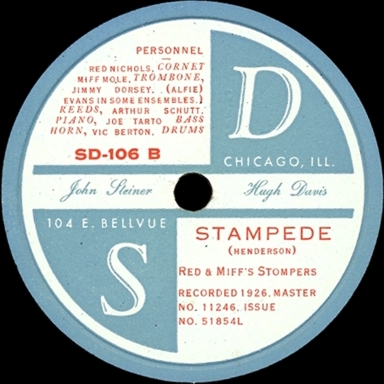
S D 106 is a reissue of two sides from Red Nichols' first session for Edison—and his very first as a leader. The two sides were first released on Edison 51854, another "hill and dale" or "vertical groove" 78. The same two titles were remade by Red and Miff's Stompers (now a quintet) for Brunswick on January 12, 1927, and for Vocalion (never released) on May 18, 1927.
Each side was recorded in A, B, and C takes, all of which were issued at one time or another on Edison 51854. Again we are indebted to the brief item by Woody Backensto ("Small Change," Record Research 102, November 1969, p. 6) for the details. Mastering from 78s in his collection, Hugh Davis used the C take of "Alabama Stomp" and the A take of "Stampede." The C take of "Alabama Stomp" later appeared on Riverside LP 1048 and Vertical Jazz 5829-8, but the Riverside and Vertical Jazz LP reissues of "Stampede" went with the C take instead of the A take.
In 1951, Steiner would release a 10-inch LP, Paramount R 201, under the title Original New York Jazzmen. The 6 sides on it were also derived from Edison (specifically, three sessions from 1926 and one from 1928), and Steiner thought that they featured some of the same musicians. But none of these sides had previously appeared on S D (and most were long enough to have required 12-inch releases on 78). It also turns out that Red Nichols, Miff Mole, and Jimmy Dorsey did not play on any of them.
All derived from Paramount sides, S D 107 through 110 were first pressed in July 1947, in batches of 25 each (150 records, 25 each of S D 105 through 110, were shipped to John Steiner on July 8, 1947). S D 110 then got a new A side before any further pressing orders came to Bishop. On February 5, 1948, Bishop shipped to Steiner 100 each of S D 107 and 108, and 50 each of S D 109 and 110. On March 11, 1948, another 2 copies of 108, 35 of 109, and 12 of 110 followed. So we can say that S D 107 through 110 were each released in 1948.
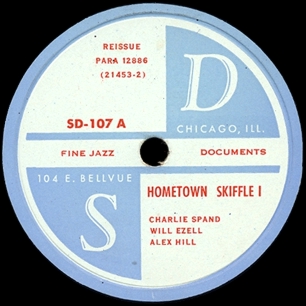
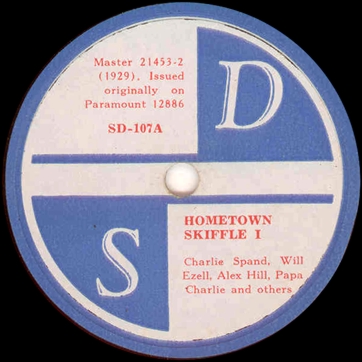
The Hokum Boys: prob. Alex Hill (voc), prob. Georgia Tom Dorsey (p); unidentified (voc); Charlie Spand (p, voc); Will Ezell (p, speech); Papa Charlie Jackson (bj, voc); Blind Lemon Jefferson (g); Arthur "Blind" Blake (g, speech); prob. Alex Hill (announcements).
Chicago, October 1929
| 107 A; originally 21543-2 | Hometown Skiffle I | SD 107 A | |
| 107 B; originally 21544-3 | Hometown Skiffle II | SD 107 B |

There are two known label varieties for S D 107. The earlier one (attested in Konrad Nowakowski's collection) uses a sans-serif type face, identifies only Spand, Ezell, and Hill on the label, and shows the (by now way obsolete) 104 East Bell[e]vue address. However, John Steiner and Hugh Davis's names in script are replaced with "Fine Jazz Documents." The first pressing appears to date from 1948. It carries a D with a P stuck in it in the trail-off area, the Dike-Polzin monogram that we also see on Session 78s and other S D's.
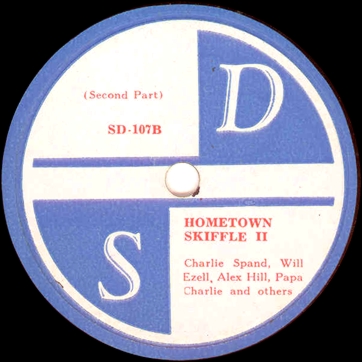
The later variety (there is a copy in Robert L. Campbell's collection) mentions Papa Charlie on the label, gives no original master number on Side B, uses a font with serifs, and lists no address for the company. It probably came out in 1949 (the year that S D 107 got reviewed in print). On both versions, the labels to the S D reissue get the original Paramount matrix numbers wrong.
The initial release of this unusual single, on Paramount 12886, took place in 1930. The two-sided 78 was a specially recorded sampler featuring a medley of brief contributions by 6 of the company's top-selling blues artists. "Hometown Skiffle" is a blanket title. In Dixon, Godrich, and Rye, the session is ascribed to the Paramount All Stars, which was the term used in Paramount's catalogue, although neither the Paramount 78 nor the S D reissue would actually call them that. The Paramount label read in full: "Descriptive Novelty: Featuring Blind Lemon Jefferson, Blind Blake, Will Ezell, Charlie Spand, The Hokum Boys, Papa Charlie Jackson."
Here, according to Dixon, Godrich, and Rye, are the actual titles for each side. Part I consisted of
Part II was actually
The opening of Part II is the work of Blind Lemon Jefferson. It was his last appearance in the studio, a few weeks before he froze to death in a rooming house hallway on December 19, 1929. Some have subscribed to the theory (rejected by Dixon, Godrich, and Rye) that Blind Blake is impersonating Blind Lemon on this record, along with making his own contribution. The announcer is cagey about Blind Lemon, saying after a few notes on the guitar, "Now folks, you can guess who this is," and summing up with "That'll git it" as the guitarist finishes. A further cause for suspicion is that when the record came out Paramount was trying to create the impression that Jefferson was still alive; memorial tributes for the label would be significantly delayed. But the guitar introduction can't be mistaken for anyone else's work.
John Steiner left Blind Lemon's name off the S D label, so maybe he agreed with the impersonation hypothesis. Or maybe he just preferred to highlight the pianistic contributions. He didn't mention Blind Blake on either variant of S D 107, and put Papa Charlie Jackson's name on just the second version.
S D 107 and 109 appear to have sold more briskly than S D 105, 106, or 108. On April 12, 1950, Bishop shipped another 166 copies of 107 and 215 more of 109. $4.00 to "set up" each run, 17 cents per pressing.
In the 1950s, Steiner, then highly interested in Caribbean music, subscribed to a wild theory about the identity of Blind Blake, who he thought might have been from the Bahamas. It was finally revealed in 2011 (in Blues and Rhythm #263) that the mysterious guitar virtuoso's real name was Arthur Blake, that he was born in Newport News, Virginia, in 1896, and that he died of tuberculosis in Milwaukee on December 10, 1934; a headstone was finally placed on his grave in a Milwaukee cemetery. Blake must have been living very quietly: his residence in Milwaukee escaped the attention of John Steiner, as well as the other blues musicians in the area.
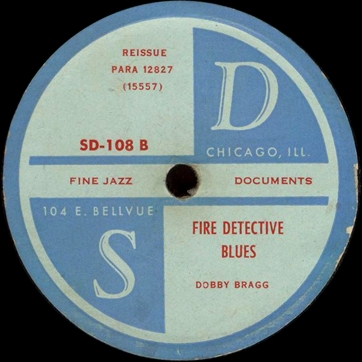
Roosevelt Sykes (p, voc) as "Dobby Bragg"; prob. Edith Johnson (speech -1)
Starr Piano Company, Richmond Indiana, September 7, 1929
| SD108A; originally 15563 | Single Tree Blues -1 | S D 108 A | |
| SD108 B; originally 15557 | Fire Detective Blues | S D 108 B |
Dobby Bragg was a pseudonym that the prolific Roosevelt Sykes used when cutting for Paramount. Our information on the S D comes from the 1950 Paramount catalog, which includes those S D issues that remained in stock. On a copy of the 78 in Dan Kochakian's collection (which lacks a label on the A side), the B side label shows the 104 E. Bellvue [sic] address and closely resembles the earlier label used on S D 107 (with "Fine Jazz Documents" in place of Steiner and Davis's names in script). Konrad Nowakowski has subsequently obtained a copy with intact labels on both sides. S D 108 was first pressed by Bishop in July 1947, 25 copies in all. The first reference to S D 108 as a "future" release took place in December 1947. S D 108 was released in 1948; at least, 100 copies were shipped to John Steiner on February 5 of that year.
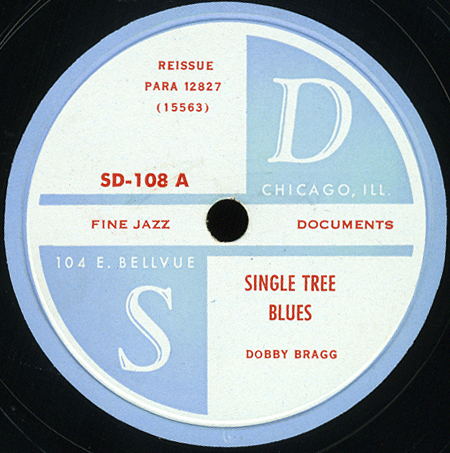
Our session information comes from Dixon, Godrich, and Rye (4th edn.). The original release was on Paramount 12827. Paramount was using the Gennett studios, located at Starr Piano Company in Richmond, Indiana, on a frequent basis in 1929. The second and last "Dobby Bragg" session, made in Grafton, Wisconsin, around August 1930, produced sides that S D didn't reissue.
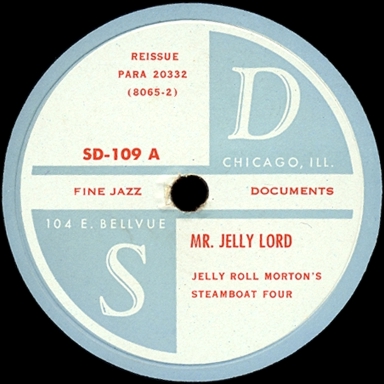
Ferd "Jelly Roll" Morton (p -1); Boyd Senter (cl -1; kazoo, bj -2); "Memphis" (comb); Russell Senter (kazoo -2).
Rodeheaver Recording Laboratories, Chicago, April 1, 1924
| S D 109 A DP1; originally 8065-2 | Mr. Jelly Lord (Morton) -1 | S D 109 A | |
| S D 109 B DP1; originally 8066-1 | Steady Roll (Stitzel) -2^ | S D 109 B |
The personnel for this date was supplied many years ago by Boyd Senter, but there is no piano on "Steady Roll." Morton is not on "Steady Roll" at all, though hope has regularly triumphed over experience, perpetuating the misattribution to "Jelly Roll Morton's Stomps Kings."
The studio is identified in the up-to-date online discography for Jelly Roll Morton at http://www.doctorjazz.co.uk/page15.html#diskrec. Here, too, it is made clear that Morton didn't play on "Steady Roll."
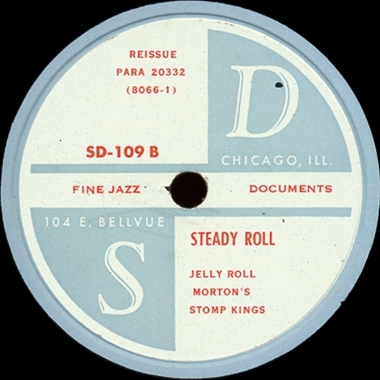
The original release was on Paramount 20332. Paramount had no studio of its own in 1924; Rodeheaver was one of several that it used during the period. S D follows Paramount in crediting "Mr. Jelly Lord" to Jelly Roll Morton's Steamboat Four and "Steady Roll" to Jelly Roll Morton's Stomp Kings. There were several releases on Paramount's satellite labels; the S D was the first reissue of either side. The single was first pressed by Bishop in July 1947 (25 copies only). It was cited in print as a "future" release in December 1947. The labels on S D 109 (extra pale blue and white, with the anachronistic address on East Bellevue) are similar to those of 107 and 108, and indicate that it was released in 1948. In fact, The Bishop Presses sent Steiner 50 copies of 109 on February 5, 1948. S D 109 carries the Dike-Polzin monogram from Pasadena, California, on both sides.
After Steiner got out of the LP business in 1955, he leased the Paramounts to Riverside. There have been many subsequent reissues with varying degrees of legitimacy.
There are surviving alternate takes of each piece: 8065 (no take number) and 8066-2. 8066-2 was used on some pressings of Paramount 20332, and 8065 was also released in the 1920s. Neither was used on S D; both have appeared on some later reissues.
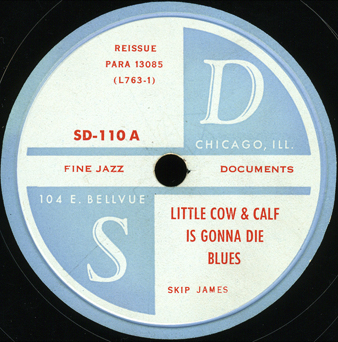
"Jabo" Williams (p, voc)
Nehemiah "Skip" James (p, voc)*.
Grafton, Wisconsin, c. January 1931*
Grafton, Wisconsin, c. March 1932
| S D 110 A A DP 11; originally L-763-1 | Little Cow & Calf Is Gonna Die Blues (James)* | S D 110 A | |
| S D 110 A DP 1; originally L-1408-1 | Fat Mamma Blues | S D 110 B |
Our information about S D 110 is drawn from a 1950 catalog put out by Steiner's Paramount label, and on Dixon, Godrich, and Rye (4th edn). As with S D 107 through 109, the release date on the "real" S D 110 was in 1948. On February 5, Bishop shipped 50 pressings of SD110AA/B to Steiner, along with 100 each of S D 107 and 108, and 50 of 109. Details on S D 110 are derived from copies in the collections of Robert L. Campbell and Konrad Nowakowski. S D 110 was mastered by Dike-Polzin in Pasadena. According to John Steiner's recollections as later reported in 78 Quarterly (see below), just one pressing run (of 300 copies) was ordered. As usual with such accounts, there was more than one actual pressing run, even if the total is approximately accurate. With S D 110, there was also a change from the initial run of 25, in July 1947, to the other copies that were made for sale.
The Jabo Williams side first appeared on Paramount 13130, and the Skip James side was originally released on Paramount 13085.
The original plan for S D 110 was two sides by Jabo Williams. An S D test pressing, offered in 2012 in a Joel Slotnikoff auction, consists of both sides of Paramount 13130 ("Polack Blues" b/w "Fat Mama"), with SD110A and SD110B in the trail-off area. The test is probably from July 1947, when Steiner ordered 25 copies from Bishop of each of S D 105 through 110.
It seems that after Steiner got hold of the Skip James side he altered his plans. On September 8, 1947, Steiner wrote to A. W. Hassler at the Bishop Presses (Steiner's copy of the letter is marked "Air"). "Master SD 110 AA is to substitute for SD 110 A which we have found unsuitable for issue." Because Jabo Williams used the word "Polack"? "We request that master SD 110 A be shipped to us in order that confusion regarding this item may be avoided, a confusion which might result if it remained in your files." The Skip James master, 110 AA, was being shipped directly to Bishop from Hugh Davis' Technical Recording Service (by prepaid express, on September 6). Something was going on. (We are assuming that the 110 A returned to Steiner was "Polack Blues" and that "Fat Mamma" was supposed to be 110 B.) On November 6, 1947, Steiner got a bill from Bishop for $15 plus sales tax on one master, one mother, and one stamper for SD 110 AA. No copies of the remodeled 110 were pressed on that occasion. The first batch of 50 was shipped to Steiner on February 5, 1948.
Skip James' legendary session for Paramount was a marathon: probably 21 titles were cut; 18 were released and consequently survive. The last six were done at the piano (with loud foot tapping, as Dixon, Godrich, and Rye take the trouble to note).
S D 110 supposedly made the James side "the first country blues to be reissued for the white collector's market." This assessment ought to be tempered, since the number features Skip James' piano rather than his guitar; during this period, Steiner focused on blues pianists. (In 1949-1950 Steiner's revived Paramount operation would reissue sides by guitar-playing bluesmen, including Leadbelly and Blind Lemon Jefferson.) Steiner may also, however, have been motivated by the condition of the original—unusually for a Skip James 78, it is completely clean, allowing James' gloriously anarchic barrelhousing to come through unimpeded.
The source could even have been a Paramount test pressing, though by the time Steiner responded to inquiries about it from blues collectors, he couldn't remember much about where he got Paramount 13085, or what happened to the copy he used.
The Skip James side was apparently never part of Steiner's personal collection. A brief item in 78 Quarterly (#6, pp. 39-40) notes that only two or three copies of Paramount 13085 ("How Long 'Buck' b/w "Little Cow and Calf") are known to have survived. In response to an inquiry from Stephen Calt, Steiner wrote that he had the "vaguest recollection" of getting one of the Paramounts he reissued, possibly 13085, from the collection of Frank Marshall Davis.
Steiner's letter to Calt does not give an accurate date for the release of SD 110. It puts his and Hugh Davis's work on checking Paramounts in various collections and assembling them for reissue in 1943, but states (obviously incorrectly) that any paper files on SD 110 were destroyed in the Uptown Playhouse fire in 1946. In fact, S D 110 is mentioned several times in his correspondence with The Bishop Presses, most notably in his letter September 8, 1947 in which he announces the change of A side.
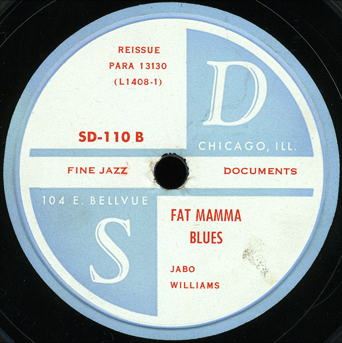
Two other sides from Jabo Williams' only recording session were released on American Music in 1949 or 1950, and are mentioned in the 1950 Paramount catalog. Obviously, Steiner had licensed the rights to reissue some Paramount material to American Music, which for a period of time during the early 1950s even used the same business address as his Paramount operation.
A set of transcriptions done by Red Nichols and His Five Pennies (at McGregor studios in Los Angeles, on four occasions from January 1945 to May 1946) have sometimes been misattributed to this S D 100 series. For instance, Tom Lord's Jazz Discography says they were released as Steiner-Davis 122 (on an album of 5 78s!). In fact, these 10 tracks were released (at a much later date) on Stardust 122, an LP produced by an outfit that had no connection with John Steiner.
On December 9 and 10, 1947, Steiner recorded Doc Evans' Dixieland combo. By this time, he had quit making new recordings for release on S D, but the matrix numbers still follow his system of recording date plus suffix.
On December 27, Billboard announced the formation of the label: "Bob Dublin, major Loop record retail shop op, has started his own record label and has already cut eight sides by the Doc Evans' [sic] Dixieland Band" (p. 21). Although Dublin may have owned the label, everything else about the operation—label printing, pressing, sales—was strictly John Steiner's doing. Down Beat promptly cited the December 9 and 10 sessions in an article on Doc Evans (December 31, 1947, p. 6). There were many errors in the account: Evans had cut 16 sides, Squirrel Ashcraft supervised the sessions, and Hugh Davis engineered them.
In a letter to the editor (published in the issue of January 28, 1948, p. 10), Steiner noted that just 8 sides had been cut, and that Ashcraft helped to finance the dates and assisted, but did not supervise. He reminded Down Beat readers that Hugh Davis was no longer his partner: "for three years he has had no association with the company." He also denied engineering the date himself, in terms that didn't invite being taken seriously: "Steiner hasn't entrusted controls to his alcohol-palsied fingers in years." This was a harmless leg-pull, but Steiner was developing a taste for invention and fabrication that would not always be so harmless.
Dublin's D1 through D4 were 78 rpm releases pressed on vinyl. As far as we can determine, they were handled at the usual pace. In other words, there was no hurry to release them. The first order for pressings of Dublin's 1 through 4 preserved in Steiner's correspondence is dated March 4, 1949. He also requested more pressings on several S D's, making it clear that he was treating the Dublin's label as his own. He asked for more copies specifically of Dublin's 1 on April 26, 1949, but since he also asked for them on shellac, we don't know whether this order was fulfilled. Another order went to Bishop in October, resulting in December delivery on a bit more than 150 copies of each of the four 78s. On June 13, 1950, nearly 100 of each of the Dublin's 78s was shipped to Steiner, from what may have been his last order with Bishop. A copy of Dublin's D2 that we have seen carries the familiar raised inscription "A Bishop Pressing" on the label to one side. After a while, Steiner specifically asked Bishop to stop embossing the labels on the records pressed there. It follows that whether embossed or unembossed, Dublin's 1 through 4 were pressed in South Pasadena. In a while these 4 Dublin's singles (with an alternate take of one of the sides substituted) would be consolidated inot a 10-inch LP in Steiner's Paramount catalogue.
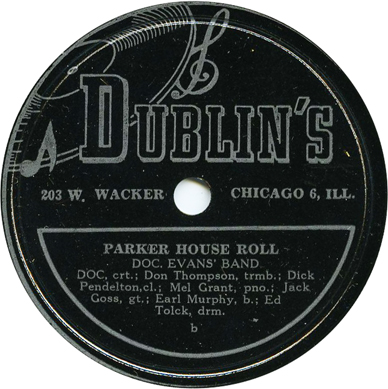
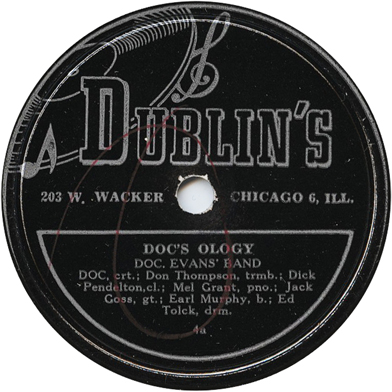
Doc Evans (cnt); Don Thompson (tb); Dick Pendleton (cl); Mel Grant (p); Jack Goss (g); Earl Murphy (b); Ed Tolk (d).
Chicago, December 9, 1947
| SD12947-3 | Lulu's Back in Town | Dublin's D1-a, Paramount CJS 106 | |
| SD12947-8 | Doc's Ology | Dublin's D4a, Paramount CJS 106 | |
| SD12947-11 | Parker House Roll | Dublin's D3b, Paramount CJS 106 |
Our immediate source is Tom Lord's Jazz Discography, Vol. 6 (Redwood, NY: Cadence Jazz Books, 1993). Personnel are as listed on the labels, except (as Lord points out) for the drummer's last name, which was misspelled "Tolck."
Other tracks were obviously made at the December 9 session, though some may have been rejected.

Doc Evans (cnt); Don Thompson (tb); Dick Pendleton (cl); Mel Grant (p); Jack Goss (g); Earl Murphy (b); Ed Tolk (d).
Chicago, December 10, 1947
| SD121047-2 | Walking My Baby Back Home | Dublin's D2a, Paramount CJS 106 | |
| SD121047-5 | One Sweet Letter | Dublin's D1-b [see note below] | |
| SD121047-6 | One Sweet Letter | Paramount CJS 106 | |
| SD121047-8 | Sposin' | Dublin's D2b, Paramount CJS 106 | |
| SD121047-10 | I Can't Believe | Dublin's D4b, Paramount CJS 106 | |
| SD121047-12 | Hindustan | Dublin's D3a, Paramount CJS 106 |
Our immediate source is again Lord's Jazz Discography, Volume 6, although we have confirmation from the actual releases. We do not know whether any further takes from this session are extant.
The original Dublin's issue of "One Sweet Letter" is thoroughly anomalous. Right in the middle of Don Thompson's 8-bar trombone solo (roughly between 1:44 and 1:49) are four seconds of silence, as though the microphone had been shut off. So far as we know all copies of Dublin's 1 do exactly the same thing. We don't know whether the master of take 5 was similarly affected, but a stretch of silence (visible to the practiced eye as straight-walled grooves on the 78) isn't the kind of thing that would just slip past quality control onto a commercial pressing. Whatever caused the damage to take 5, its deliberate issuance on a commercial release is an early example of "Steinerizing"—the weird deceptions and antics to which John Steiner would occasionally be prone over the next decade. Whether they were meant as inside jokes, or were responses to frustration (for instance, at not being able to find source material of adequate quality), they have long spread confusion and annoyance among collectors of the records he put out.
On the Paramount LP, take 6, fortunately complete and gapless, would be substituted. (Some alleged copies of take 6 in circulation today are not from the LP: they were made from take 5 dubbed from Dublin's 1-b, sped up, with the gap in Thompson's solo spliced out. Why?).
A 1952 catalog, included as a booklet in the first Paramount LP, CJS 101, indicates that the four Dublin's 78s were still in stock and for sale from Steiner's Paramount operation. Later the material from these sessions would be reissued on its own 10-inch LP, Paramount CJS 106; see the Paramount LP listing below.
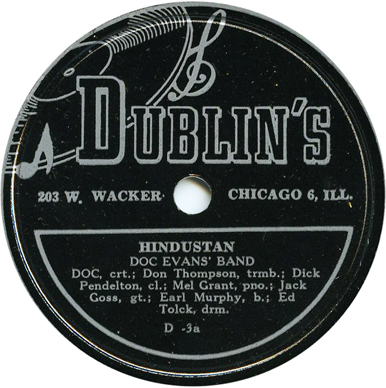

We had thought that the Dublin's label had one purpose in life, to release the Doc Evans session. But there was at least one more Dublin's 78, and loose labels for it, like the loose labels for Dublin's 1 through 4, are still in the John Steiner Collection at the University of Chicago Library.
Dublin's V8 featured Steiner's recordings of two nickelodeons from the Valentine's collection (a story in Billboard about one of these, a player piano with attachments, gives the address of Valentine's as 1986 Milawaukee Avenue; "Dime Play Back," July 16, 1949, p. 98). Details remain scarce regarding Dublin's V8, but obviously John Steiner had developed an interest in player pianos, pianolas, and other mechanical keyboards (up through the late 1920s, solo pianists in a variety of genres often recorded piano rolls as well as records). Although we doubt the pressing totals on Dublin's V8 exceeded those for an "experimental lot," we will see a further indication of his mechanical keyboard fascination when we get to Paramount 14027 (below).

Shortly before the Dublin's project, Steiner began working toward a more ambitious goal: purchasing the Paramount label outright from the Wisconsin Chair Company. At least that's what was happening behind the scenes. The initial publicity made it appear that Paramount releases would be coming from the original company. Only later would it emerge that Steiner now owned what was left of the label and was putting out the reissues himself.
Paramount had halted new recording in its Grafton, Wisconsin studio during the summer of 1932, and had quit pressing and shipping by the end of 1933. A few metal parts were leased to other companies. Around 1935, most masters and mothers and stampers, along with unsold 78s, were moved into a disused Wisconsin Chair company building for storage—some were disposed of immediately because they were damaged, others were taken home over time by employees, records were Frisbeed off the top of the building by boys from the area, a few metal parts were even used to cover holes in walls. And most of what remained—be it metal or shellac—was sold for scrap at the height of the wartime shortages, in the summer of 1942. Virtually the only mothers to be preserved were around 100 that were leased to Jack Kapp's Champion label in the 1933-1935 period and stored at the old Gennett facility in Richmond, Indiana. (Others appear to have been dealt to the American Record Company during this period; it still isn't known whether any of those are extant.)
So it was an odd sort of purchase. What Steiner got for his outlay was the trademark and master rights, plus the Chicago Music Publishing Co (he had modest success in renewing copyrights, though his attempt to do this for Paramount 14030 led Lovie Austin to hire a lawyer). He obtained virtually no tangible assets—no record stock except some unsold and not very well preserved Black Swan 78s, hardly any masters or plates (Steiner would eventually retrieve 51 that Paramount had leased to Champion), certainly no real estate. He got a few bookkeeping files—the recording ledgers had also been disposed of during a wartime drive—and was offered the recording apparatus, which he found so crude and antiquated that he kept a few styli for test purposes and got a Milwaukee junk dealer take the rest. For his reissues of historic recordings that had originally appeared in the 1920s and 1930s, Steiner usually had to dub from issued 78s on Paramount or an affiliated label, or from test pressings that had fallen into the hands of collectors.
The March 1948 issue of the Jazz Finder announced the deal. Under the title "Paramount Back," the item (on p. 5) made it appear that the label's original parent company, the New York Recording Laboratories, would be responsible for the reissues. (Steiner had no trouble opening a post office box under that name in Port Washington, Wisconsin.) Collectors must have guffawed—or groaned—at the next sentence: "New records will be pressed as far as possible from the original masters, the company announced." But the item veered back into approximate realism with: "Well-known collectors who are assisting in the selection of items to be reissued include John Steiner, George Hoefer, Jr., Paul Eduard Miller, Hugh Davis, and Don Haymes." Steiner and his fellow collectors were, for the most part, providing the 78s to be reissued. Supposedly 34 sides would be reissued "annually," and buyers would be encouraged to purchase a $10 subscription that would entitle them to 12 78s from each year's reissue output. Nothing came of this particular plan. A few of the artists mentioned in the initial advertisement (e.g., Piano Kid Edwards, Skip James, and Jabo Williams) would not end up being reissued on Paramount at all.
A different, scaled-back version was related in George Hoefer's "Hot Box" column in Down Beat (May 4, 1948, p. 11). Under the heading "Steiner reissues", Hoefer declared that "The first eight sides to be reissued by the New York recording laboratories of Port Washington, Wisconsin, through the efforts of John Steiner are hereby announced: ... These all will be on the original Paramount label." Again later in the year, Steiner notified George Hoefer of an impending release of Paramount reissue singles. But it was not until early 1949 that he got the 14000 series launched.
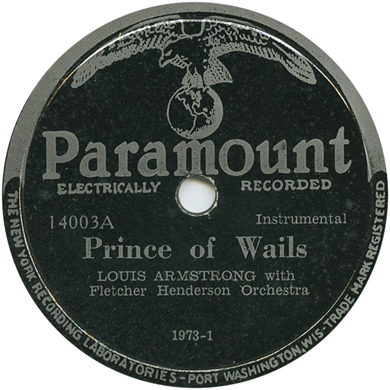
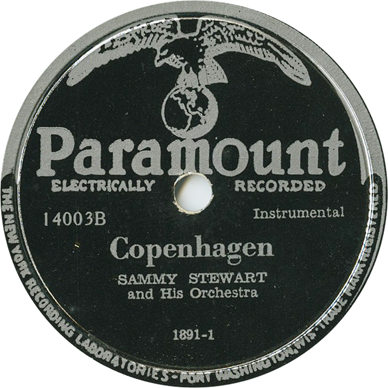
The initial package consisted of 13 single reissues of vintage 1920s blues and jazz performances. As the copy of Paramount 14001 in Tom Kelly's collection indicates, the 78s were pressed by Bishop in southern California. On March 7, 1949, Steiner ordered pressings of Paramount 14001 through 14008 and 14010 through 14013 "to the extent of the labels submitted." He promised to send labels to 14009 along later. "Please do not used BISHOP PRESSES imprint in label area of SD, Paramount, or Dublin Records now on order." On April 26, he asked for pressings of Paramount 14006 and 14009 "to the extent of the labels supplied." He made at least one follow-up order for more of Paramount 14001. Of the 26 sides in the package, 13 were taken from Paramount proper—the remainder from subsidiary imprints (Puritan), from labels that Paramount had purchased (Black Swan, QRS), or from previously unissued material. Among of the artists represented in the project were Johnny Dodds, Tommy Ladnier, Louis Armstrong, Fletcher Henderson, Jelly Roll Morton, James P. Johnson, Clarence Williams, and Ma Rainey.
Two of the sides in this group originated from a Squirrel Ashcraft session of more recent vintage. Some sources say it had been recorded in Chicago in 1941 for the World imprint, but we would like confirmation on that. Another two came from Leadbelly's first commercial session, done for the American Recording Company in 1935; Steiner had been able to license these sides.

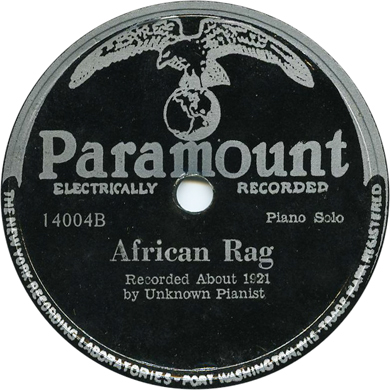
Steiner took the unusual step of sending all 13 releases to reviewers all at once—but asking them to space out their reviews so only one would appear each month. Not all complied…
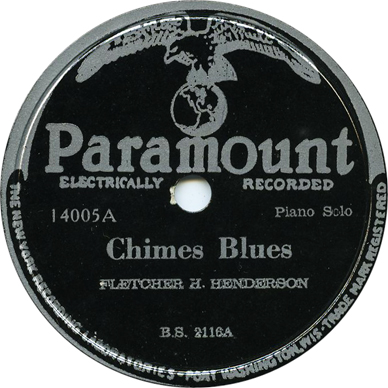
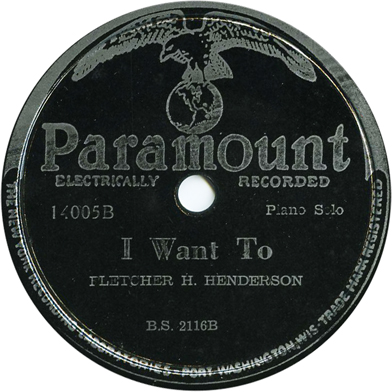
By the middle of 1950, Steiner had released 19 further Paramount 78s; again, most of the sides came from the old Paramount or its subsidiaries. Four had already appeared in the S D 100 series. He'd used Bishop exclusively for the first 13 Paramounts. A bill from Bishop dated July 29, 1949 inlcudes set up changes for what appear to be Paramount 14016, 14017, and 14019, so more Paramounts got pressed there. But Steiner was starting to use RCA Victor for mastering and pressing. Paramount 14028 carries QB-10187-1-D9 in the trail-off vinyl of its A side, and QB-10188-1-D9 on side B. These indicate mastering by RCA Victor in 1949. (QB-10189-1-D9 is the matrix number on a different Steiner project from 1949: Down Beat 101 a, by the Eddie Getz Quintet.) RCA Victor was marketing its custom mastering and pressing services heavily at the time. The peculiar (for that era) ordering of the matrix numbers, with D9 for 1949 at the end instead of the beginning, was characteristic of records pressed in 1947 through 1948 for Pfau, a small company based in Milwaukee. If for any reason Steiner couldn't order RCA masters and pressings from Chicago, he could easily do it from his home town.
Steiner ended his 78 series with Paramount 14032. Two more Leadbelly sides came from his first commercial session for ARC. A handful of others had been recorded for Gennett or Autograph; two were derived from piano rolls made by QRS. Meanwhile, the Kansas City Frank Melrose release was made to look as though it originated with Paramount, when in fact the sides used had been recorded for Steiner and Davis's rival Signature—and released on that label with different titles.
Steiner didn't try to keep all of the Paramounts to himself. In 1949 and 1950, he licensed additional old Paramount sides to the American Music label, which put them out on 8 singles. AM 1 through 8 can be seen in Steiner's 1950 catalog, alongside his Paramount releases—and several S D's, some released not that long ago, that remained in stock. Most of the AM's and the S D's were still in Steiner's catalog in 1952. Steiner also distributed American Music's new recordings of traditional jazz from the 1940s; AM's are listed on the backs of several of his Paramount LPs, and for a while the Paramount liner notes referred to something called "AM/Pm," as though the companies were a joint venture.
Sources: On what happened to Paramount's metal parts, the authoritative source is "Paramount's Legacy: What Happened to the NYRL's Recorded Inventory," by Alex van der Tuuk (http://www.mainspringpress.com/nyrl.html). The article also covers Steiner's revival of Paramount, though we take issue with some of the information provided there (e.g., the sequencing of Steiner's Paramount 78 releases, and the release dates for his subsequent series of 10" LPs).
| New Paramount release | Artist | Title | Original release |
| 14001A | Johnny Dodds with Richard M. Jones Jazz Wizards | Hot and Ready | Paramount 12705 |
| 14001B | Johnny Dodds with Richard M. Jones Jazz Wizards | It's a Low Down Thing | Paramount 12705 |
| 14002A | Tommy Ladnier and Orchestra | Edmonia Henderson blues vocal | Jelly Roll Blues | Paramount 12239 |
| 14002B | Tommy Ladnier and Orchestra | Edmonia Henderson Blues Vocal | Lazy Daddy | Paramount 12239 |
| 14003A | Louis Armstrong with Fletcher Henderson Orchestra | Prince of Wails | Paramount 20367 |
| 14003B | Sammy Stewart and His Orchestra | Copenhagen | Puritan 11359 |
| 14004A | Joe Smith and Orchestra | Ethel Finnie Vocal | Heart Breakin’ Joe | previously unissued |
| 14004B | Recorded About 1921 by Unknown Pianist [Eubie Blake] | African Rag | Emerson (unissued test pressing) |
| 14005 A | Fletcher H. Henderson | Piano Solo | Chimes Blues | Paramount 12143, Black Swan 2116A |
| 14005 B | Fletcher H. Henderson | Piano Solo | I Want To | Paramount 12143, Black Swan 2116B |
| 14006A | Leadbelly | All Out and Down | Banner 33359 |
| 14006B | Leadbelly | Packin’ Trunk | Banner 33359 |
| 14007A | Jelly Roll Marton [sic] & Orch. | Big Fat Ham | Paramount 12050-A |
| 14007B | Jelly Roll Marton & Orch. | Muddy River Blues [sic] | Paramount 12050-B |
| 14008A | Clarence Williams Orchestra | Squeeze Me | QRS 7005 |
| 14008B | Clarence Williams Orchestra | New Down Home Rag | QRS 7005 |
| 14009A | James P. Johnson | The Harlem Strut | Paramount 12144 |
| 14009B | Fletcher Henderson | Piano solo | Unknown Blues | Black Swan 2026 |
| 14010A | Meade Lux Lewis | Geo. Hannah, vocal | Freakish Blues | Paramount 13024 |
| 14010B | Meade Lux Lewis | Geo. Hannah, vocal| Boy in the Boat |
Paramount 13024 |
|
| 14011A | Ma Rainey | Vocal, acc. Jug Band | Deep Moaning Blues | Paramount 12706 |
| 14011-B | Ma Rainey | Vocal, acc. Jug Band | Traveling Blues | Paramount 12706 |
| 14012A | Fletcher Henderson's Orchestra Featuring F. Henderson, Coleman Hawkins, Tommy Ladnier, Joe Smith | Swamp Blues | Paramount 12486 |
| 14012B | Fletcher Henderson's Orchestra Featuring F. Henderson, Coleman Hawkins, Tommy Ladnier, Joe Smith | Off to Buffalo | Paramount 12486 |
| 14013A | Bill Priestley, cornet with the Squirrel Ash Craftsmen | Riverboat Shuffle | previously unissued |
| 14013B | Bill Priestley, cornet with the Squirrel Ash Craftsmen | Sunday | previously unissued |
| 14014 A | King Oliver’s Jazz Band with Louis Armstrong & Johnny Dodds | Riverside Blues | Claxtonola 40292 (S D 100) |
| 14014 B | King Oliver’s Jazz Band with Louis Armstrong & Johnny Dodds | Mabel’s Dream | Claxtonola 40292 (S D 100) |
| 14015 A | King Oliver’s Jazz Band with Louis Armstrong & Johnny Dodds | Southern Stomps | Paramount 12088 |
| 14015 B | Young’s Creole Jazz Band | Dearborn Street Blues | Paramount 12088 |
| 14016 A | Ma Rainey & Her Jazz Band | Jelly Bean Blues | Paramount 12238 |
| 14016 B | Ma Rainey & Her Jazz Band | Countin’ The Blues | Paramount 12238 |
| 14017-A | Leadbelly | Blues Shouter | Black Snake Moan | Banner 33360 |
| 14017 B | Leadbelly | Blues Shouter | ‘Fore Day Worry | Banner 33360 |
| 14018 A | Blind Leroy Garnett | Piano solo | Chain ’Em Down | Paramount 12879 |
| 14018 B | Blind Leroy Garnett | Piano solo | Louisiana Glide | Paramount 12879 |
| 14019 A | Jimmie Blythe | Piano solo | Mr. Freddie Blues | Paramount 12370 |
| 14019 B | Jimmie Blythe | Piano solo | Lovin's Been Here and Gone to Mecca Flats | Paramount 12224 |
| 14020 A | Meade Lux Lewis, Piano | Geo. Hannah, Vocal | Alley Rat Blues | Paramount 13048 |
| 14020 B | Meade Lux Lewis, Piano | Geo. Hannah, Vocal | Molasses Sopper Blues | Paramount 13048 |
| 14021 A | Jungle Kings | Teschemacher, Mezzrow, Spanier, Sullivan, Condon, Lanigan, Krupa | Vocal: Red McKenzie | Friars' Point Shuffle | Paramount 12654 |
| 14021 B | Jungle Kings | Teschemacher, Mezzrow, Spanier, Sullivan, Condon, Lanigan, Krupa | Vocal: Red McKenzie | Darktown Strutters' Ball | Paramount 12654 |
| 14022 A | Blind Lemon Jefferson | Jack O’Diamonds | Paramount 12373 |
| 14022 B | Blind Lemon Jefferson | Chock House Blues | Paramount 12373 |
| 14023 A | Johnny Dodds Four | New There’ll Come a day | Paramount 12525 |
| 14023 B | Young’s Creole Jazz Band | Tin Roof Blues | Paramount 20272 |
| 14024 A | King Oliver with Clarence Williams Orchestra | I’m Through | QRS 7040 |
| 14024 B | King Oliver with Clarence Williams Orchestra | Longshoreman Blues | QRS 7040 |
| 14025 A | Sara Martin with King Oliver & his Band | Death Sting Me Blues | QRS 7042 |
| 14025 B | Sara Martin with King Oliver & his Band | Mistreating Man | QRS 7042 |
| 14026 A | Kansas City Frank’s Footwarmers [Bud Jacobson’s Jungle Kings] |
Blue Slug I [Laughing at You] |
Signature 904A |
| 14026 B | Kansas City Frank’s Footwarmers [Bud Jacobson’s Jungle Kings] |
Blue Slug II [Opus No. 1 Sans Melody] |
Signature 903B |
| 14027 A [14024 A on label] |
Duke Ellington [sic] | Nickelodeon Transcription | Jig Walk | QRS piano roll |
| 14027 B [14024 B on label] |
Fats Waller, Piano [sic] | Pianola Transcription | The Mess-Around (A Wholetone Study) [sic] | QRS piano roll |
| 14028 A | Paul Mares’ New Orleans Rhythm Kings | Livery Stable Blues | Gennett (unissued) |
| 14028 B | Charles Pierce & his Orchestra featuring Muggsy & Tesch | Nobody’s Sweetheart | Paramount 12616 |
| 14029 A | Johnny Dodds with Blythe's Ragamuffins | Ape Man | Paramount 12428 |
| 14029 B | Johnny Dodds with Blythe's Ragamuffins | Your Folks | Paramount 12428 |
| 14030A | Lovie Austin’s Serenaders with Dodds and Ladnier | Galion Stomp | Paramount 12380 |
| 14030B | Lovie Austin’s Serenaders with Dodds and Ladnier | Henry Williams, Vocal | Chicago Mess Around | Paramount 12380 |
| 14031A [14301A on label] |
Alice Moore with Ike Rodgers & Henry Brown | Black and Evil Blues | Paramount 12819 |
| 14031B | Alice Moore with Ike Rodgers & Henry Brown | Broadway Street Woman Blues | Paramount 12819 |
| 14032A | Johnny Dodds | Tiny Parham, piano | Clarinet Solos | Oh Daddy | Paramount 12471 (S D 102) |
| 14032B | Jelly Roll Morton | Piano Solo | Frog-I-More Rag | S D 103 |
Our sources for this list were: The 1950 Paramount Records catalog, courtesy of Tom Kelly; Booklet included with the first Paramount LPs, CJS 101, R 201, and CJS 104, courtesy of Konrad Nowakowski; George Hoefer’s "Hot Box" column announcing the first 13 issues (Down Beat, February 25, 1949, p. 13); Robert M. W. Dixon, John Godrich, and Howard Rye, Blues and Gospel Records, 1890-1943 ( 4th edn.). Oxford: Clarendon Press, 1997; Tom Lord’s Jazz Discography; and the John Steiner Collection (Box 76), University of Chicago Library.
According to Dixon, Godrich, and Rye, both take 1 and 2 take of "Jelly Roll Blues" by Edmonia Henderson were released on Paramount 12239; it is not known which one was used on Paramount 14002.
Paramount 14011 uses take 2 of each Ma Rainey side; copies of Paramount 12706 using takes 1 and 2 of each are extant.
Paramount 14022 uses take 2 of Blind Lemon Jefferson’s "Jack O’Diamond Blues"; copies of Paramount 12373 with take 1 and take 2 both circulated.
According to Lord, takes 1 and 2 of "Dearborn Street Blues" by Young's Creole Jazz Orchestra were both released on Paramount 12088; it is not known which one was used on Paramount 14015.
And takes 1 and 2 of "Tin Roof Blues" both saw release on Paramount 20272; again, it isn't known which one appeared on Paramount 14023.
A little more about Frank Melrose seems warranted here, since Steiner put some of his work out on the Paramount reissue label after announcing, but never following through, on S D releases.
Franklyn Taft Melrose was born in Sumner, Illinois, on November 26, 1907. He was the younger brother of Walter and Lester Melrose. He initially learned to play the violin, which can be heard on his 1940 recording of Stuff Smith's ode to inhaling, "If You'se a Viper." Later, he took up the piano, which is the instrument heard on all of his other recordings. Although Melrose did a fair amount of touring in his younger days (hence his nickname "Kansas City Frank"), his home base after 1930 was Chicago (later, Hammond, Indiana). Starting in the mid-1920s, he hung out with Jelly Roll Morton, who became a significant though non-exclusive infuence on his style.
Melrose first recorded in 1928 with a group led by Junie and Jimmy Cobb; he also recorded with them in 1929 in groups billed as the Windy Rhythm Kings and Kansas City Tin Roof Stompers; he that same year he cut sides with the Beale Street Washboard Band, which included Johnny and Baby Dodds. In January 1930, Melrose recorded with the Cellar Boys (a group that included Wingy Mannone, Frank Teschemacher, and Bud Freeman). In 1929 and 1930, Melrose also made sessions under his own name for Gennett, Brunswick, Paramount, and the American Record Company. For Gennett in February 1929, and again for Brunswick in March of that year, he and drummer Tommy Taylor recorded a pairing of "Jelly Roll Stomp" and "Pass the Jug"; the sides were frequently mistaken for the work of The Roll himself, recording under a pseudonym. Also in March 1929, Melrose commenced a relationship with Paramount, cutting two solo takes each of "Rock My Soul" and "Whoopee Stomp" (really the old stride favorite "The Boy in the Boat") under the handle "Broadway Rastus." In November 1929, he made a second session for Paramount with a five-piece combo that was billed as "Kansas City Frank and his Footwarmers"; they were responsible for "Wailing Blues" and "St. Louis Infirmary Blues." His last commercial sessions under his own name consisted of five solos cut for Brunswick over a three-day period in April 1930. (None were released at the time, but the sides eventually came into the possession of John Steiner, as we will see.)
During the 1930s, relatively little jazz got recorded in Chicago. Melrose's work with trumpeter Pete Daily beginning in 1932, with clarinetist Bud Jacobson in 1933, and early electric guitarist George Barnes (around 1937) went undocumented, as did his participation in a Lee Collins band with Lonnie Johnson on 12-string guitar. One exception was a single solo piano recording (probably done on a 12-inch disk) that ended up in the hand of Frank Lyons (see below for more about this). But early in 1940, Frank Melrose assembled an 8-piece rehearsal band that got few paying gigs (on account of its repertoire, which was full of rags and 1920s songs and Jelly Roll Morton compositions) but laid down 18 surviving sides at Gamble's recording lab; on three of these they were joined by singer June Davis. Pete Daily and Boyce Brown, who played alto sax in the band, were separately recorded by John Steiner and Hugh Davis, who also cut some sides by Melrose himself. But Steiner esteemed Melrose's piano solos far more highly than his work as a bandleader, and he and Davis were not responsible for these octet sessions. The 18 sides informally recorded by one of the engineers at Gamble's were bought by jazz collector Frank Lyons, who finally made them available for release on a Delmark CD in 2006. Other lacquers that were recorded at Gamble's, such as a handful retained by Pete Daily, appear to have been lost.
Melrose made his last sessions with Bud Jacobson's Jungle Kings for Bob Thiele's Signature label. The first session took place on January 13, 1941; supposedly Signature could do nothing with it, because everyone was drunk and the balances were off, and the musicians agreed to remake the same four titles at no charge. The remake session came off successfully on March 13, leading to two singles on Signature. In the summer of 1941, faced with a need for a steadier income, Melrose took a day job as a machinist in a war industry. Frank Melrose was murdered on September 1, 1941, aged only 33; he was found at 135th and Oglesby on the far South Side, either the victim of a hit-and-run driver or of a beating by thugs. Pete Daily, who had played trumpet in Melrose's 1940 band, testified at an inquest, then promptly high-tailed it for Canada. That meant Daily thought the Mob was involved. Melrose left a widow and three young children.
"Blue Slug" (which took up both sides of Paramount 14026) was made out to be a previously unissued recording. Steiner misleadingly credited it to "Kansas City Frank's Footwarmers," inviting the inference that it originated from the November 1929 quintet session from Paramount. The reviewer at The Record Changer realized that something was amiss: "I'm a little baffled by this one. The band name would lead one to suspect Herb Morand on trumpet, Frank Melrose on piano, and Tommy Taylor on drums. But there are a lot more people around for this one and I am not familiar enough with Morand to be sure ..." That's because "Blue Slug" actually came from one of the Signature sessions by Bud Jacobson's Jungle Kings, which featured three reeds (Jacobson's clarinet, Bud Hunter's clarinet and tenor sax, and Joe Rushton's bass sax and clarinet) alongside Carl Rinker's trumpet in the front line. However, the same four titles were supposedly made at each session—indeed, two versions of each of the four at the remake session—and nothing called "Blue Slug" was among them. Yet according to Bruyninckx, "Blue Slug" had been salvaged from the rejected session of January 13, 1941. Obviously Steiner was trying to conceal the origin of Paramount 14026. In a letter to Storyville magazine (no. 71, 1977, p. 176), Fred Cox noted that both sides had been issued on Signature after all—they were actually cut on March 13, 1941.
I expected to hear some original renditions, but after repeated playings and comparisons my ears told me that Blue Slug I was musically identical to Bud Jacobson's Jungle Kings Laughing At You (1609) on Signature 904A and that Blue Slug II was identical to Opus No. 1 Sans Melody (1611) on Signature 903B … so why the change in artist credit and titles?
We had thought that none of Steiner and Davis's own recordings of Melrose survived the Uptown Playhouse Theater fire; however, a piece called "Cosmics" is said on the back liner to Paramount CJS 103 to have come from the "Davis collection"—and it is too long, at 4 1/2 minutes, for a 10-inch 78. Whether Hugh Davis actually had anything to do with it is unclear; Steiner later attributed it to Frank Lyons.
Sources on Frank Melrose: Ted Toll, New (but Old Style) Chicago Band Features a Hot Banjo!!, Down Beat, 7(5), p. 20 (March 1, 1940); Pete Daily, Barrelhouse Frank Melrose, Piano Jazz no. 1, pp. 10-12 (1945); John Steiner, Kansas City Frank, Jazz, 1(8), 1943 [reprinted in Piano Jazz no. 1 (1945)]; Bucklin Moon, Review of Paramount 14026, The Record Changer (February 1951), p. 12; Howard Rye's article in Barry Kernfeld (Ed.), The New Grove Encyclopedia of Jazz, 2nd ed., Vol. 2, p. 745 (London: Macmillan, 2002); Mike Meddings' detailed Web site on Frank Melrose at http://www.doctorjazz.co.uk/page3.html; and Bob Koester's notes to Kansas City Frank Melrose: Bluesiana (Delmark DE-245, a CD released in July 2006).
"Jig Walk" on Paramount 14027 is derived from a piano roll of an early Duke Ellington composition. According to Bjorn Englund ("Jig Walk and Ellington," Names & Numbers 51, October 2009, p. 1), the piano roll was actually cut by J. Lawrence Cook, who was in charge of piano rolls at QRS, and released as QRS 3565 in August 1926. Steiner made a suprisingly poor quality recording of the roll, as played by a Nickelodeon with a mechanical drum attachment; his shout of "Oops!" doesn't help anything either. The flip to 14027 was attributed to Fats Waller. Though Waller made some of his own rolls for QRS, this was not among them. According to Howard Rye in Names & Numbers 52 (January 2010), it was actually "Snakes Hips," also played by J. Lawence Cook and released as QRS 2256 or Q108. Steiner recorded it off a player piano with only 65 notes—the wrong model for Cook's piano roll, and the source of the whole-tone effects. Steiner had already experimented with recording off Nickelodeons, with two sides appearing (in a highly limited edition) as Dublin's V8.
"Livery Stable Blues" (on Paramount 14028) was a previously unissued master from the New Orleans Rhythm Kings' second session for Gennett in 1922.
While finishing his Paramount single series and catching up on his delayed releases for S D, Steiner somehow had to time to start another label (he might have had a partner for this, but, if such was the case, we don't know who). His Down Beat enterprise was unusually obscure, even for him, and the competition with Jack Lauderdale's substantially better-known company from Southern California (which changed its name to Swing Beat, then to Swing Time) didn't help. Down Beat was effectively a salvage operation, for jazz material from Milwaukee that had been recorded (and in some cases not released) for a short-lived company in 1947. The tracks saved from oblivion were not the kind that Steiner most liked: they were distinctly modern in style. Still, the Down Beat labels don't just have a Steinerish look to them, including the small "a" and "b" side designations: loose labels to all three releases are in the John Steiner Collection.
Down Beat inherited part of the remains of a company called Chord. In March 1947, a jukebox operator in Milwaukee named Michael Cudahy announced that he had recently recorded and pressed records by three local artists for distribution on the jukeboxes that he serviced. One of the artists was jazz alto saxophonist Eddie Getz.
In the summer, Cudahy announced that he was launching a new label called Chord. Most of the company's recording activity took place in the summer and fall of 1947, with some participation in the industry-wide scramble to assemble material before the second Petrillo ban hit. By January 1948, the ban was in force, the company had a fairly ambitious artist roster and release schedule—and not nearly enough revenue was coming in. Cudahy immediately cut back on the pop releases he had planned. By July or August 1948, Cudahy had turned over masters to some of the artists who'd been signed to his label, closed Chord down, and moved to the West Coast. Cudahy actually took a job at Perfection Plastic Products, a Pasadena-based competitor to The Bishop Presses (and an occasional user of masters and mothers from Dike-Polzin). One last Chord, a reissue of a Christmas single by Joe Gumin, actually appeared in the fall of 1948 with Perfection identified as the manufacturer.
Chord had pop performers on its roster, plus polka bands, and a little bit of jazz, which was contributed by Eddie Getz's quintet and the Sheboblou Trio (Lou Stein, Bob Carter, and Shelly Manne). Getz got at least two releases on Chord; the Sheboblous had at least one. Down Beat ended up releasing two Sheboblou records and one by Eddie Getz. Whatever Steiner originally had in mind for Down Beat, the whole thing came and went in 1949.
In September 1950, Steiner stopped pressing 78s with Bishop. On September 28, he got back all of the masters and mothers for the S D and Paramount singles Bishop had pressed. He may have continued to order 78s for RCA Victor for a bit longer, but he was phasing them out. Toward the end of 1951 Steiner began a program of both reissues and new releases in a new line of Paramount 10-inch LPs; the first Paramount LP was announced in October 1951 and actually released in January 1952.
As a pilot project, a double Squirrel Ashcraft LP had already been released early in 1951—specifically as "two 10" LP records in folder." Three of the four labels, which as with many of the earliest 10-inch LPs were still 78-size, are in the John Steiner Collection at the University of Chicago (Side 1A, Side 2A, and Side 2B). The title was Informal Session at Squirrel's and the performers were jokingly identified as The Sons of Bix's. The probable date of recording was around July 4, 1950. Now that Konrad Nowakowski has tracked down a copy, we also know what was on Side 1B. The matrix numbers in the vinyl are from RCA Victor (EO-LQB-13042-1 A, EO-LQB-13043-1 A. EO-LQB-13044-1 A1, and EO-LQB-13045-1A 1, respectively). They indicate mastering and pressing in late 1950.
The LPs were simply numbered 1 and 2, in silver on black with no company logo. They were sold in a brown envelope with a folding enclosure, with extensive liner notes pasted onto one side of the envelope (Steiner would later boast of having introduced the envelope). The 2 LPs were first listed as for sale in a Paramount Distributors ad in the Record Changer, February 1951, p. 34, then mentioned by George Hoefer in the April issue of Downbeat. These must have circulated among Ashcraft's musical companions—and not a lot farther.
The Paramount 100 series would include three later relases by Ashcraft and crew. Otherwise it featured such artists as Jimmy Yancey, Doc Evans, Bud Freeman, Frank Melrose, and Cassino Simpson, and continued through 14 known releases. The recordings had multiple origins, but the largest single source was what Steiner and Davis (and later, just Steiner) had done in the 1940s for S D and Dublin's, followed by new material, and finally by recordings that Steiner had acquired from the original Paramount label or from other defunct companies. There were two jazz releases in other number series: one each in the Paramount 200s and in the S D 1000s. A Paramount 600 series that featured calypso acts continued for about 12 releases. Below is a list of the blues and jazz releases; the calypso releases are outside our purview.
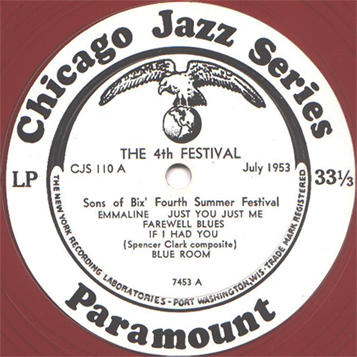
Squirrel Aschraft's first release for the Paramount 100 series was his second LP for Steiner. In the booklet included with CJS 101 and R201, CJS 104 is announced as Second Session at Squirrel's. (Past discographies have listed it as "Informal Session at Squirrel's," but that was the no-brand double 10-inch LP.)
In turn, CJS 108 was the Third Session. Courtesy of Dave Ludwig, we have now seen photos of the covers and both sides of this LP. The recording date is given as July 4, 1952.
Next, a copy of CJS 110 in the collection of John Dixon is titled The 4th Festival (not the third, as indicated in older listings). And, finally, the extensive notes on the back of CJS 110 announce a 5th festival planned for the 4th of July weekend, 1954. Did it take place? Was it recorded? Was it supposed to appear on CJS111? (No album with that number actually appeared.)
The same booklet out of the first 10-inch LPs, Paramount CJS 101 and R201, shows 4 LPs on the American Music label (by rediscovered New Orleanians like Bunk Johnson and George Lewis) alongside the first 4 Paramounts. The alliance with American Music seems to have kept going all the way through 1954. The back liner to the piano duo LP, CJS 112, refers to an entity called "AM/Pm," and attaches Steiner's home address to this combined operation.
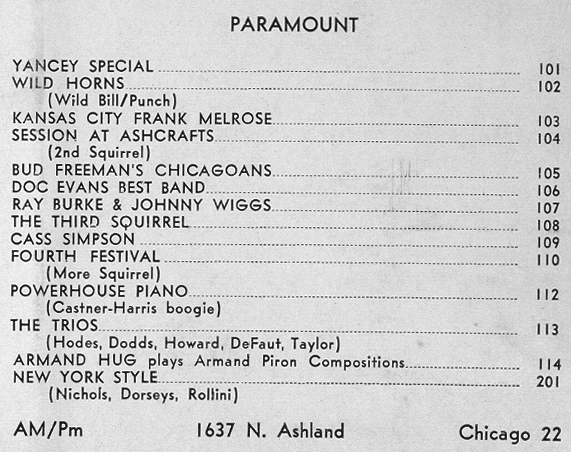
The first Paramount LPs came out early in the 10-inch era exhibit some of the quirks of pioneering microgroove releases. Most had liners on one side but not both; instead of a jacket, they were packaged in a heavy, glossy folded gold or green manila envelope. On the back of CJS 112, the fine print at the bottom states, "We boast having designed the AM/Pm LP envelope in 1950, a covering which despite its higher cost is finding increased favor (stronger seams, dust-proof, non-abrasive, minimum shelf space, coded color, etc.)." The "increased favor" was no longer in evidence in 1954—cardboard jackets were already the rule—but never mind. The original pressings of each LP were made of red vinyl.
| [No Label] 1 | Informal Session at Squirrel's | The Sons of Bix's | February 1951 |
| [No Label] 2 | Informal Session at Squirrel's | The Sons of Bix's | February 1951 |
| CJS101 | The Yancey Special | Jimmy Yancey | January 1952 |
| CJS102 | The Wild Horns | Wild Bill Davison and Kid Punch Miller | 1952 |
| CJS103 | Kansas City Frank Melrose | Frank Melrose | 1952 |
| CJS104 | Second Session at Squirrels | Squirrel Ashcraft | 1952 |
| CJS105 | Panorama | Bud Freeman and the Chicagoans | 1953 |
| CJS106 | The Dublin Date | Doc Evans' Greatest Jazz Band | 1953 |
| CJS107 | New Orleans Jazz Chamber Music Section | Ray Burke & the New Orleanians | 1953 |
| CJS108 | The Third Squirrel | Squirrel Ashcraft | December 1952 |
| CJS109 | Cassino Simpson | Cassino Simpson | 1954 |
| CJS110 | The 4th Festival | Squirrel Ashcraft | 1954 |
| CJS112 | Powerhouse Piano | Tom Harris and Charlie Castner | 1955 |
| CJS113 [CJS112 on labels] |
The Trios | Art Hodes | 1955 |
| CJS114 | Armand Hug Plays Armand Piron | Armand Hug | 1955 |
The Jimmy Yancey LP came from a session recorded on December 23, 1950, in Chicago. It was not Steiner's handiwork, but that didn't prevent him from laying claim to it. In a Yancey memorial article by George Hoefer (Down Beat, November 2, 1951), who had a test pressing, the material was said to have been recorded by Julie and Frank Rose at the Myron Bachman Studio and intended for LP release. Hans Fantel was also involved with the recording, though he was not credited by Hoefer, and it was done on tape. The Roses tried to sell it to RCA Victor, but were not successful; they next offered it to John Steiner. (For the full story see Konrad Nowakowski, "Jimmy Yancey: The Paramount LP," Names & Numbers 38, July 2006, pp. 2-8).
It's interesting to note that Yancey's December 1943 recordings had been a mainstay of S D's contemporary and rival, the Session label. When released, the LP was billed as "Yancey's last recording." It turned out that the pianist had made one more (for Atlantic) prior to his death in 1951.
CJS 101 was announced for release in October 1951. It was probably not really released till January 1952. George Hoefer reviewed it in the Feburary 8, 1952 issue of Down Beat. That same month the Clef Music Shop in New York City advertised it, along with CJS 104, in the Record Changer.
The most common of the Paramount LPs, the Yancey was pressed on the usual red vinyl, which in some cases was marbled with black, and (in later pressings) on black vinyl. There are both 78-size and full-size LP labels for this issue, which obviously went through more pressings than most Steiner product. CJS101 was also the only Paramount LP to be sold in a cardboard jacket (which has no release number printed on it). Some copies also contained the booklet that had been designed for inclusion with CJS 104, Second Session at Squirrel's.
The numbers 621 and 622 appeared on the A and B sides, respectively, but as Nowakowski has noted (Notes & Numbers, 2006, p. 5), these were more of the non-matrix numbers that Steiner had already applied to some of his 14000-series Paramounts. The original numbers assigned by Bachman Studio remain unknown.
In the trailoff area, the A side of CJS 101 shows 621 57 and the B side shows 622 57. While 621 and 622 are non-matrix numbers, 57 seems to indicate who mastered the sides. We are not sure where it came from, as Steiner had quit using Bishop and CJS 101 shows no traces of being mastered at RCA Victor.CJS102, The Wild Horns, used four of the 1941 Punch Miller tracks that Steiner and Davis had recorded at the H & T Tavern for Side B. Two of the sides had been out for a hot minute on S D 509 and 510; the other two were previously unreleased. The A side of CJS102 consisted of excerpts from early recordings by Wild Bill Davison. The CJS102 labels were all 78-size. It was pressed on red vinyl; oddly, the Davison side carries the same non-matrix on the label as the A side of CJS 101: 621. In the runoff area, it reads 621 57 (also the same as on the A side of CJS 101, even though obviously it's a different master). The B side of CJS 102 carries 623 on the label and 623 57 in the vinyl.
The Frank Melrose LP, Paramount CJS103, exemplifies all that was problematic in Steiner's latter-day output.
It consisted of seven tracks. Side A presented four solo sides from the previously unreleased Brunswick sessions of April 1930; George Avakian was thanked for unearthing them and authorizing their release. These were authenticated by Frank Melrose in 1940, and, according to John R. T. Davies in Storyville 71 (1977, p. 176), Steiner bought the masters on February 5, 1951. (In 1958 Steiner and Hulme's discography put the location as New York City and the year as 1928.)
On the B side were what Steiner alleged to be two alternate takes of Melrose's Paramounts from March 1929 ("The original masters are either worn or corroded making those used now preferred"), which had been duets with drummer Tommy Taylor. Unfortunately, if there had been alternate takes Steiner hadn't gotten his hands on them. Instead, it appears that Steiner hired Jelly Roll Morton specialist John "Knocky" Parker to rerecord the piano parts; it's not been revealed whether he also hired a drummer to assist in the rerecording Steiner was now heavily involved in trickery, for reasons that made sense only to him. He did eventually admit Parker's involvement, in a 1958 discographical article with Mike Hulme in Matrix 20: "on these two titles KNOCKY PARKER contributed overlays because the original masters were in very poor condition" (p. 6). In a letter to Storyville 71 (1977, pp. 175-176), Fred Cox reported that he realized on comparing the tracks with the original "Broadway Rastus" release that they were not from the same session. Around 1952, he continued, Parker told Warren Huddlestone that he had rerecorded the two sides at Steiner's request.
Finally, "Cosmics," "recorded originally for the Davis Collection," was long enough at 4 1/2 minutes to keep the B side down to 3 tracks. It is a well-recorded solo outing, made at an unknown date. In the Steiner-Hulme discograpy from 1958, it is dated as "1930s" and said to have been recorded by Frank Lyons. On account of the imposture over the Melrose Paramounts, some have suspected that "Cosmics" is not by Frank Melrose, but no other provenance has been documented. (Even the four sides from 1930 have unfairly come under suspicion because of the Knocky Parker caper.)
In his notes to CJS 103, Steiner made an appeal for clean copies of the original Paramount takes, and for clean copies of Melrose's recordings for Gennett. Apparently, these went unanswered, for no revised and expanded edition ever appeared. Meanwhile, "Blue Slug," which Steiner had spread across two sides of a Paramount 14000 series 78, was left off the LP—maybe he preferred not to court further trouble with another record company.
The Melrose LP was sold in a green envelope. It was pressed on red vinyl. Some copies have what would normally be considered a back liner attached to one side; others have an art cover depicting Melrose instead. The labels are silver on black, in the same size and format that Steiner had been using on his 78s.
The Squirrel Ashcraft LPs were recorded in the homes of pianist Edwin "Squirrel" Ashcraft and cornetist Bill Priestly. Every year Ashcraft would sponsor a get-together with his old jazz-playing buddies on the July 4 holiday break and perform a "Bix Summer Festival." Steiner recorded the group—which he would informally call the Sons of Bix or the Sons of Bix's—on July 4 breaks from 1951 to 1953 (these were billed as the Second, Third, and Fourth sessions on the LPs; the 2 "Informal Session" LPs could have been recorded around July 4, 1950, but the No Name release gives no information about the date). A lawyer known to the bar as Edwin M. Ashcraft III, Squirrel had a music background, recording in the Princeton Triangle Club band in 1926-28 and working as an accordionist with the Bix's band the Wolverines. Bill Priestly was an architect whose musical specialty was playing the cornet in the Bix tradition.
According to the discography by John Steiner and Mike Hulme in the Matrix 20 (1958), Second Session at Squirrel's on CJS104 was recorded at the Sons of Bix Festival from July 2nd through July 4th, 1951. Personnel consisted of Doc Evans (cornet), Bud Wilson (tb), Spencer Clark (bass saxophone), Squirrel Ashcraft (p), Jack Howe, Bill Priestly, and Howard Kennedy (guitars), Phil Atwood (b), and Hoyt Smith (d). Seven newly recorded tracks were included, along with another consisting of excerpts from Red McKenzie and Bunny Berigan recordings in Bill Priestly's collection. The LP was the last one to be released with 78-size labels.
CJS104 was pressed on red sinyl with Ash 5 on the label to one side (ASH-5 57 in the trailoff) and Ash 6 (ASH-6 57) on the other. Would the 4 sides on the No Name package have been ASH-1 through ASH-4?

The Bud Freeman LP compiled the released sides from the S D session of September 30, 1946 (see SD7, 8, and 9 above) filling out its 8 tracks with two from Freeman's appearance with the Paul Jordan Quartet at the Opera House, supposedly on September 1, 1946 and once intended for use on Green Records (see SD11). CJS 105 was packaged in a gold envelope; the red vinyl pressings carried regulation-size black labels. Matrix numbers are 93046-x on the label (93046-x 57 in the vinyl) and, on the other side, 93046-z (93046-z 57).
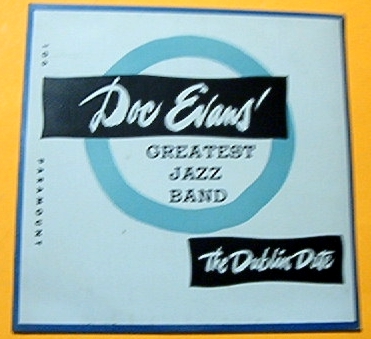
Steiner had recorded the Doc Evans album for Dublin’s Record Shop in December 1947 (see the session details above). Mercifully, he replaced the Steinerized take 5 of "One Sweet Letter" with an intact take 6; otherwise the tracks were identical to those previously released on Dublin's 78s. A copy of the LP in Tom Kelly's collection has a light blue art cover pasted on one side of a gold envelope. The labels are black, and of the typical 10-inch LP size. There were also copies with regular-size green labels; both label types are preserved in the John Steiner Collection.
Side A on the LP was marked 121047 A on the label and 121047-A 251 in the vinyl. On side B, the matrix number were 121047 B and 121047-B 251. Why 251 replaced 57 on these master is not known.
Two LPs by New Olreans groups that featured Raymond Burke on clarinet and Johnny Wiggs on cornet, were independently produced by Dr. Edmond Souchon, a traditional jazz aficionado from New Orleans who played guitar and sang on them: S D 1001 (see below) and Paramount CJS107. CJS107, credited to Ray Burke & the New Orleanians, was released with regular-size green labels. Obviously not of Chicago origin, it was the first to replace "Chicago Jazz Series" at the top of the label and "Paramount" at the bottom with "Paramount" at the top and "Jazz and Blues Classics" at the bottom.
CJS 107 was pressed on red vinyl; the matrix numbers were 10752 A on the A side, with 10752-A and A-15356 x in the runoff area. The B side carried no further designation on the label, but 10752-B and A-15357 x in the trailoff.
CJS108, The 3rd Squirrel was recorded in Chicago on July 4, 1952, and issued with green full-size labels. It was pressed on red vinyl with 7452 A and 7452 B on the labels (these should be self-explanatory). In the vinyl, old 57 was back: 7452-A 57 and 7452-B 57.
The Cassino Simpson LP on CJS109 had been recorded all the way back in 1942 by Steiner and Davis (see SD1 above), but only one side from that session had previously seen release, on S D's Christmas 1947 record.
A copy in the collection of Konrad Nowakowski has an art cover pasted on one side of a gold envelope. The labels are white, in a typical 10-inch LP size. There are some copies with green full-size labels.
Pressings were on red vinyl. On CJS109 the labels showed matrix numbers 51742 A and 51742 B. In the vinyl, 51742-A 57, with a logo of an M inside a C under the 57, and 51742-B 57 CM, arrayed similarly.
Regrettably, the acetates and lacquers for most of the recordings that Steiner and Davis had made in Chicago bars and concert halls were no longer available, having been consumed in the Uptown Playhouse Theater fire.
CJS110, The 4th Festival, was recorded in July 1953 with another Squirrel Ashcraft lineup. It was released with white 10-inch LP labels.
In 1954, Steiner did some extensive recording of his own at two house parties in St. Louis (July 30 at J. M. Phillips' home and August 1 at Bill Atkinson's). The main attraction was pianist Pete Johnson, but supposedly Tom Harris, Charlie Castner, and Donald Stoll also took turns at the piano and Bill Atkinson sang on two numbers. Steiner pressed some private LPs of the material and spliced and resequenced his master tape as though readying it for an LP release, but none of the Pete Johnson tracks materialized on Paramount. In the early 1970s, some tracks from these sessions appeared on two LPs on the After Hours label; a more complete presentation has since been made available on Document DOCD-1017, which was released in 1999 with a discographical note by Konrad Nowakowski.
Meanwhile, items by Tom Harris and Charley Castner did appear on CJS112, under the title Powerhouse Piano, but these were studio recordings—not items from anybody's house party. Still in a Steinerizing mood, the label owner crafted a totally fictitious historical background, according to which Harris and Castner, who were too young to have done any such thing, had been hanging out with Jimmy Yancey and Jimmy Blythe back in the 1920s. A copy of CJS 112 in Konrad Nowakowki's collection is packaged in the gold envelope Unusually, it carries both an art cover and a back liner. Maybe the scarcest of the Paramount LPs, CJS 112 was advertised for sale in the Record Changer, Volume 14, number 2 (March 1955). It had green 10-inch LP labels.
The final Paramount LPs were newly recorded trad jazz sessions under the leadership of Art Hodes and Armand Hug.
The Art Hodes LP consisted of two trio sessions, one cut on December 10, 1953 with clarinetist Volly DeFaut and drummer Jasper Taylor, the other done on November 22 of that year with Darnell Howard and Baby Dodds in those respective positions. It was supposed to be numbered 113 (Steiner was not superstitious) and was advertised under that number—but the labels read CJS112. Very rare today, it was released with black regular-size labels. These used the "Jazz and Blues Classics" version of the label, even though a Chicago connection was clearly present.
The Armand Hug release, on CJS114, featured recordings made by Jack Babin in New Orleans, on October 1 and 2, 1953. It was pressed on red vinyl with a large silver on black Paramount label; 110153 was the Side A matrix number, coupled with 110253 for Side B. (In the trail-off area, the A side matrix carries an additional prefix, V-4605.) Packaging was in the customary gold envelope, this time with an art cover on the front and liner notes by Harry and Edmond Souchon on the back, with a 1954 date for the notes.
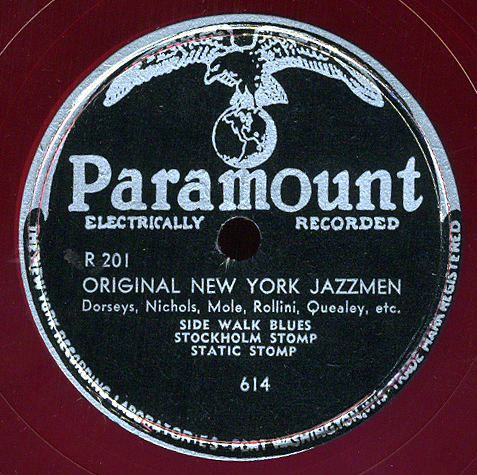
| R S 201 | The New York Style | As Defined by Its Originators | 1951 |
The Paramount 200 series was actually launched around the same time as the 100 series. The sole release, R201, featured musicians who had been based in New York rather than Chicago. On the labels, which are the same size as on Paramount 78s, the title is Original New York Jazzmen and the number is R201. On the single-sided liner, the title is The New York Style As Defined by Its Originators and the number is R S 201. The two copies we have seen were packaged in the gold envelope. A copy in Konrad Nowakowski's collection has the original liner, in tattered condition but still attached to the envelope. A copy in Robert Campbell's collection is missing the liner, which must have come completely unglued.
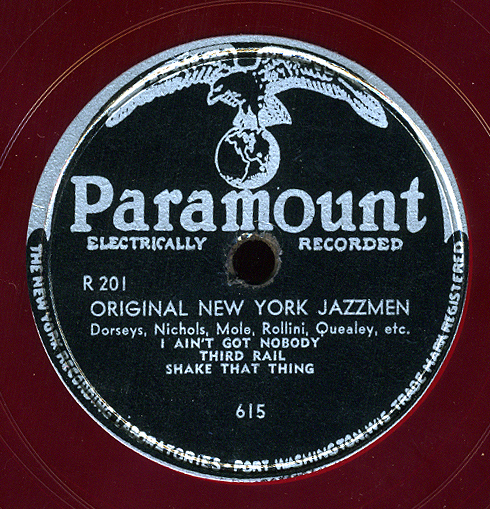
The tracks on R201 were derived from the Edison label, but did not include any of the four sides previously reissued on S D 105 and 106. Steiner went with a completely different batch of Edison tracks, all of which were originally credited to the California Ramblers. Each track was at least 3 1/2 minutes in length; several must have required 12-inch 78s on their original release; and there was room for just 6 of them on a 10-inch LP.
From the California Ramblers section of Tom Lord's Jazz Discography—interestingly, none of these entries mention the Paramount LP—we have drawn the following information about recording dates, personnel, and original releases. (Lord also lists Edison 51737 under the Golden Gate Orchestra, which was sometimes used as a pseudonym for the California Ramblers, and is not otherwise given its own section in his discography.) Steiner was not always meticulous about titles; where these vary his renditions appear in square brackets.
In his notes on the original liner, Steiner identifies the sides by their matrix numbers and gives detailed but conjectural personnels. He is approximately correct on the dates of the first 4 sides, but puts the last two in the spring of 1927. He does not give original issue numbers or mention Edison, but does say, "We acknowledge gratefully the licensing of this material for reissue."
As per Lord, the six sides are:
The Paramount labels claimed that the personnel included "Dorseys, Nichols, Mole, Rollini, Quealey, etc." and Steiner (as per his notes) was convinced that Miff Mole played on all six. Tommy Dorsey, Adrian Rollini, and Chelsea Quealey did play on some of these sides; Jimmy Dorsey, Red Nichols, and Miff Mole did not. To be fair to Steiner, the California Ramblers, whose output is much better researched today, were an extremely prolific studio aggregation. They recorded for many different labels with frequent changes of personnel, and the group did include Nichols, Mole, and Jimmy Dorsey on some other occasions.

In 1955, one of Steiner's last 10-inch LPs actually appeared on an S D label, instead of a Paramount label. The reason for this variance remains elusive, as a companion LP, also produced in New Orleans by Edmond Souchon, with Ray Burke and Johnny Wiggs featured, had previously appeared in the Paramount 100 series. In any event, it would be the last time Steiner used the S D logo.
| CJS1001 | Wiggs-Burke Big 4 | Wiggs-Burke Big 4 | 1955 |

When the majors forced a changeover in the long play format in 1955, Steiner quit issuing records. He was not willing to gear up for 12-inch LPs. Instead, he leased Paramount sides to reissue companies—most notably to Riverside. And working with Bill Russell, he conducted an interview project with legendary Chicago jazz musicians—Natty Dominique, Baby Dodds, Preston Jackson, Jimmy Bertrand, Roy Palmer, Ikey Robinson, Lee Collins, and Butterbeans and Susie—for the Tulane Jazz Archives. This was in addition to the informal interviews he had conducted earlier and would conduct later on (such as his 1958 sit-down with Max Miller, intended as background material for a press booklet).
In 1959, Steiner advanced the funds to record collector Bob Koester to enable him to purchase Seymour’s Record Mart, from which Koester built his Jazz Record Mart and expanded his Delmark label. Steiner was flush at the time, as he had just concluded a lucrative suit against ABC-Paramount for using the "Paramount" name on its records. Supposedly Steiner was irritated that people would mistakenly try to contact him through ABC-Paramount, which refused to forward his mail. His friend Squirrel Ashcraft did the legal work. In a settlement ABC gave Steiner $10,000 to obtain the exclusive use of the Paramount trademark—and to get him to go away. Steiner was no longer operating a label under that name, so it was fine with him.
Sources on the latter-day Paramount issues: George Hoefer, "Rest Easy Friends, It’s Ike On Paramount 1735," Down Beat, 5 May 1948, p. 11; George Hoefer, "Chicagoan Unearths Rare Duke Nickelodeon Roll," Down Beat, 28 July 1948, p. 11; George Hoefer, "13 Paramount Reissues Fodder for Collectors," Down Beat, 25 February 1949; George Hoefer, "LPs of Informal Session at Ashcraft’s Released," Down Beat, 6 April 1951, p. 11; George Hoefer, "New York Style Explored in Paramount LP Reissue," Down Beat, 27 August 1952, p. 8.
After years working for several laboratories, Steiner began teaching at the University of Illinois-Chicago in the early 1960s, continuing his professorial career into the 1970s. Steiner maintained a home in Milwaukee and a residence in Chicago. Koester said, "His legendary apartment at 1637 North Ashland was a gathering place for jazz fans and collectors at time when a lot of great trad jazzmen lived here: Hodes, Darnell, Dodds, Brunis, Miff [Mole], Spanier." Later Steiner moved to Greenview Avenue, where he renovated an old city bathhouse into a Chicago residence. In 1968, with George Finola and Harriet Choice, Steiner helped found the Jazz Institute of Chicago (JIC). Steiner loaned some of his record collection and some of his files to the JIC.
In 1970, Steiner sold Paramount (minus the name, which he no longer owned) and S D to a New Orleans label entrepreneur George Buck, who operated host of reissue labels devoted largely to traditional jazz, blues, and pop. Buck had begun his operation in 1951 with Jazzology, which focused on recording Chicago-style traditional jazz. Other labels that Buck added over the years included Black Swan, Audiophile, American Music, Circle, Progressive, Solo Art, Southland, and his own G.H.B. Around the same time, Steiner sold Paramount's old Puritan trademark to Dave Samuelson and Broadway to Billy Thomas. Biograph Records acquired the old Paramount eagle and globe design. Because Steiner's 1955 deal with Riverside had no expiration date, its successors Fantasy and Concord Records have kept reissuing Paramounts, while Buck's operation has used its Black Swan label for similar purposes.
On June 3, 2000, Steiner died at his home in Milwaukee. He left four truckloads of his collection and cache of jazz research to the Chicago Jazz Archives, which are currently housed by the University of Chicago. The photo from the Red Norvo-Stuff Smith session, which we reproduced above, comes from the Archives. The photos of loose labels (Steiner saved copies of the labels for most of the sides he released) are from the John Steiner Collection in the University of Chicago Library Special Collections.
Sources on Steiner’s life: George Hoefer Jr., "The Hot Box," Down Beat, 1 February 1944, p. 13; Howard Reich, "John Steiner, Chicago Jazz Expert," Chicago Tribune, 9 June 2000. The most invaluable biographical information on Steiner came from Bob Koester’s obituary, on the Delmark Records website, the Rhythm & News page [http://delmark.com/rhythm.steiner.htm], accessed 23 November 2003. Another useful biographical source was Paige Van Vorst’s obit in Jazzbeat (Vol. 12, No. 1), excerpts of which appeared on the Jazz Institute of Chicago website as edited by Sue Markle under the title "A Passion for All Things Jazz: John Steiner" [http//jazzinstituteofchicago.org], accessed 27 November 2003. We also made use of a Q&A feature on Steiner that appeared in 78 Quarterly; Pete Whelan, "The Man Who Bought Paramount," 78 Quarterly 7 (1992): 30-40; and Robert Pruter’s interview with Bob Koester, 5 December 2003.
Click here to return to Red Saunders Research Foundation page.